Knives
Knives are essential tools that have accompanied humans throughout history, used both in the kitchen and in various everyday activities.
Made from high-quality materials, these knives are designed to offer precision and durability. Whether you are looking for a knife for home or professional use, this category offers a wide selection that covers all your needs.
Each knife has been meticulously designed to ensure a clean and efficient cut, adapting to all types of tasks, from food preparation to more specialized manual work.
The tang, also known as the spine, is an essential component in the construction and performance of a sword. This critical element extends from the blade into the handle, playing a fundamental role in securing the blade to the handle and providing more than just support; it adds stability, balance, and strength to the sword. Often referred to as the weapon's "skeleton," the tang is where the forces applied during use converge, contributing to its effectiveness in combat.
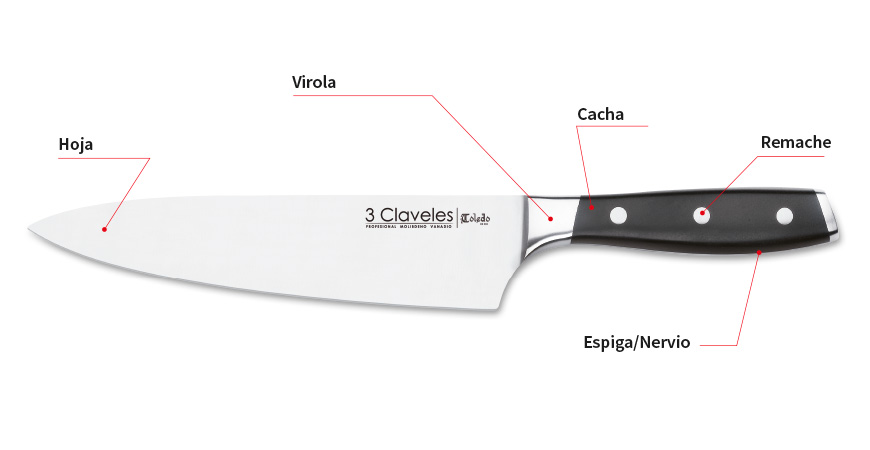
Compared to other types of cutlery, the tang in swords tends to be longer, spanning almost the entire handle. This additional length not only ensures greater control and balance but also allows the user to handle the sword with superior precision and effectiveness. The shape and size of the tang can vary depending on the specific design and purpose of the weapon. For instance, some tangs are square or rectangular to optimize grip, while others take on a more streamlined design that reduces weight without sacrificing strength.
The connection between the tang and the handle is crucial for the durability of the sword. This bond is often achieved through fastening techniques such as welding or riveting, which ensure that the blade is firmly held during use. Additionally, the pommel located at the bottom of the handle not only protects the tang from potential damage but also contributes to the aesthetic of the weapon, being a distinctive element in many sword designs.
The quality of the tang is fundamental; a poor design or a bad manufacturing process can compromise both the maneuverability and functionality of the sword. Investing in swords that have high-quality tangs, as well as performing good maintenance, can not only enhance performance in combats or displays but also preserve the integrity of the weapon over time.
Therefore, the tang or spine of a sword is a crucial factor that ensures a solid connection between the blade and the handle, facilitating balance and stability. This has a significant impact on the user's effectiveness, becoming an aspect that every fencing enthusiast or white weapon collector should consider when selecting a sword. The correct choice of this component can make the difference between a satisfying and a frustrating use experience.
The term false edge refers to the edge that is located on the opposite side of the main edge of a blade weapon, such as a knife or sword. This complementary edge, located near the tip of the blade, plays a crucial role in the tool's effectiveness when cutting, as it allows for finer and more precise cuts. Additionally, its design can influence the overall performance of the weapon, making it more versatile in its practical and technical use.
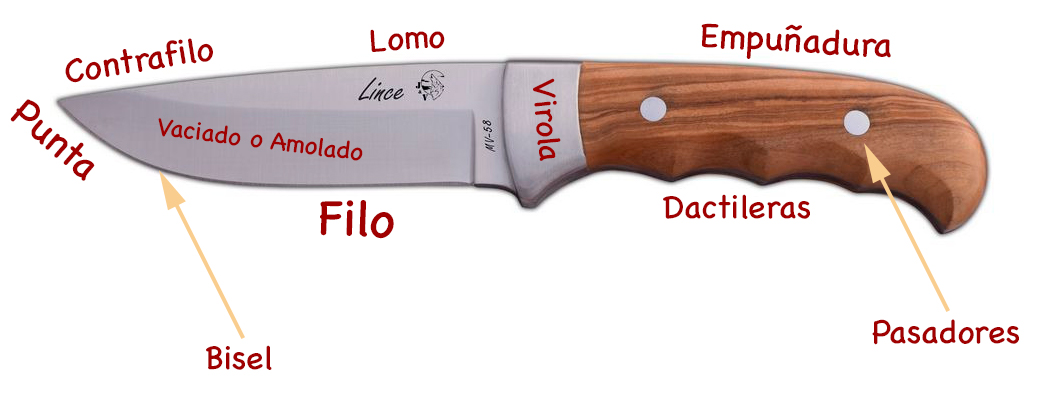
In the context of swords, the false edge is not as common, as most are doubled-edged weapons. However, its presence can be found in certain models designed specifically for combat, where every detail of the blade is considered essential. For example, in medieval swords or Japanese katanas, the false edge can be used in various ways, such as to deflect an attack and make cuts at different angles, thus providing a tactical advantage in close combat situations.
Interestingly, in some swords, the false edge can even be sharper than the main edge, making it a tool not only for finer cuts but also a potentially dangerous element in untrained hands. Therefore, effective handling of a false edge requires specialized skills and training, as improper use can result in injuries to both the wielder and others. Thus, it is essential that those wishing to incorporate such a blade style into their repertoire of bladed weapons seek proper guidance and training in appropriate combat techniques.
When considering the acquisition of a weapon that includes a false edge, buyers should also pay attention to the legal regulations governing the possession and use of bladed weapons in their country or region. This ensures not only their safety but also compliance with the law, promoting responsible and conscious use of these historical and functional tools.
The sheath or scabbard for a sword is an essential accessory for sword owners, as it serves as a protective layer that allows for the safe storage and transport of the weapon. Regardless of whether it is an antique sword, a period recreation, or a collector's piece, having the right scabbard is crucial to ensure its integrity and longevity.
There are various considerations when choosing a sword sheath or scabbard. These can vary in shapes, materials, and designs, and the correct selection must take into account not only the type of sword in question but also the personal needs and preferences of the user. The most common materials for making sheaths include:
- Wood: Usually offers exceptional durability and a classic design. Wooden sheaths are elegant and can be carved with intricate details.
- Leather: This material is popular for its flexibility and aesthetics. Additionally, leather can provide a non-slip effect on the sword handle.
- Metal: They offer great protection against impacts but can increase weight and may require special care to avoid corrosion.
- Plastic: Generally lightweight and economical, although they may not provide the same durability as other materials. Ideal for recreational or temporary use.
The design of the sheaths is also diverse, ranging from simple and functional options to decorative models that may include artistic details, engravings, or inlays. Some sheaths are equipped with closures and straps that secure the sword inside, preventing any accidents or damage.
When selecting a sheath or scabbard, it is important to consider the intended use of the sword. If it is a display item, aesthetic features may be prioritized. On the other hand, for activities like martial arts practice or historical recreation, durability and ease of transport will be key aspects.
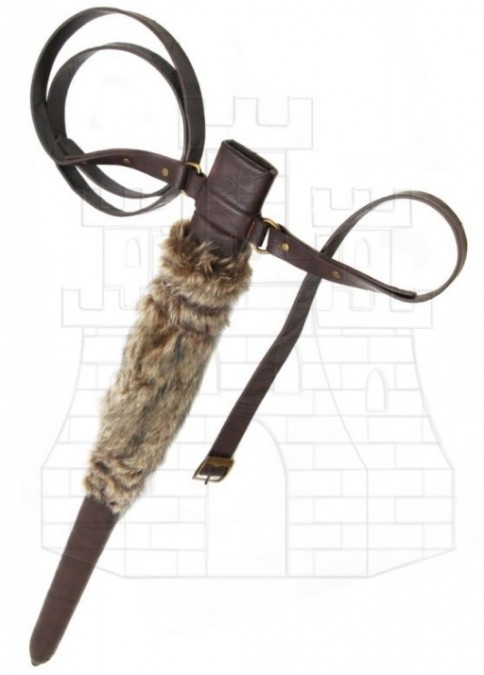
Choosing the right sheath is not just a matter of protection, but it can also reflect the personality and aesthetics of the bearer. Additionally, regular maintenance, such as cleaning and caring for the materials, is vital to prolong the lifespan of both the sword and the scabbard. Be sure to follow the manufacturer's recommendations for the specific care of each material.
The blade edge of the sword is one of the most essential and determining characteristics of this type of weapon, as its cutting edge plays a crucial role in its effectiveness in combat. This edge is designed not only for cutting; it is also fundamental in the use of various disarmament and defense techniques, which can make a difference in high-pressure situations. The geometry and design of the edge can vary considerably depending on the type of sword, whether it is a katana, a foil, or a longsword, making each model have a distinctive purpose and be optimized for different fighting styles.
It is important to note that the edge is not restricted to swords; other blades, such as knives, daggers, axes, and machetes, also possess an edge whose configuration determines their capacity and effectiveness. Characteristics such as the shape, thickness, and angle of the edge directly influence the cutting ability and, therefore, the performance of the weapon. Understanding these variables is crucial for selecting the right tool for each activity, thus ensuring optimal performance in practical or training situations.

The sharpening process of the edge can be carried out using various techniques, ranging from manual methods to the use of specialized tools, such as sharpening stones or electric machines. Keeping a well-sharpened edge is critical not only in combat situations but also during training activities that require precision and speed. Proper maintenance of the edge not only improves the weapon's performance but also increases safety when handling it, minimizing the risk of accidents.
In addition to its functionality, the blade edge can have aesthetic and symbolic connotations. Many swords feature decorative designs on their edge, which not only enhance their visual appeal but may also reflect the cultural heritage or history of the owner. This aspect turns the sword into an object of art, highlighting the craftsmanship of the blacksmith and the cultural significance it represents.
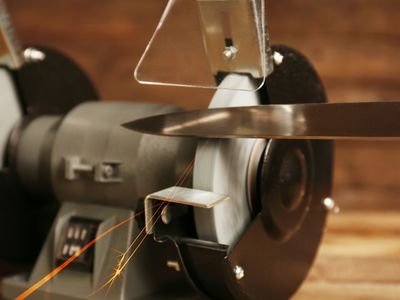
Taking care of the edge is vital to ensuring its longevity and effectiveness. It is recommended to clean and lubricate it regularly with suitable products, which helps prevent oxidation and corrosion. It is also essential to protect the edge from impacts and falls, as any damage could compromise its performance and user safety. This is especially relevant for collectors and weapon enthusiasts, who must pay attention to the storage and display conditions of their possessions. Additionally, it is crucial to respect the applicable legal regulations concerning the possession and use of blades, which may vary by jurisdiction and can include requirements for registration, storage, and transportation, which is essential to ensure responsible and safe ownership.
The blade of a cutting weapon is the key component that provides both performance and functionality to a wide range of weapons, including swords, knives, daggers, axes, and machetes. From the guard, designed to protect the user's hand, to the tip, the blade plays a crucial role in combat techniques, enabling various actions such as cutting, striking, or piercing targets. The specific characteristics of the blade, such as its length, width, and shape, vary significantly and are fundamental to its effectiveness in different contexts of use, whether in culinary activities, recreational use, or combat sports.

Regarding manufacturing materials, blades can be found made of various types of steel, each with characteristics that impact both their performance and maintenance. Below are some of the most common types:
- Carbon steel: This type of steel is highly valued for its ability to maintain a sharp edge, making it an excellent choice for applications that require precise cuts. However, proper care is crucial, as it can rust if exposed to corrosive elements.
- Stainless steel: Offers superior resistance to corrosion, making it ideal for those looking for a low-maintenance and highly durable weapon, especially in humid environments or where water exposure is constant.
- Damascus steel: In addition to its strength, this type of steel is famous for its ornamental surface patterns, making it a popular choice among those who value both aesthetics and functionality in their weapons.
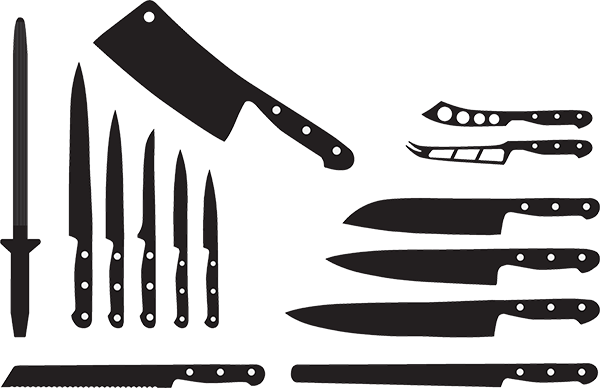
In addition to materials, the shape of the blade is a crucial aspect that affects its performance. Some of the most common blade shapes include:
- Straight blades: Especially useful for precise and direct cuts, they are ideal for tasks that demand precision.
- Curved blades: Allow for smoother movement, making them perfect for tasks that require broader and more dynamic cuts.
- Sharp-tipped blades: These are specifically designed for more effective piercing, being very useful in situations that require quick and effective penetration.
The choice of blade shape should be based on the combat technique that is planned to be used, as well as the specific conditions of each confrontation. Furthermore, the personal style and preferences of the user are equally fundamental when selecting a weapon, providing a subjective factor that should not be ignored.
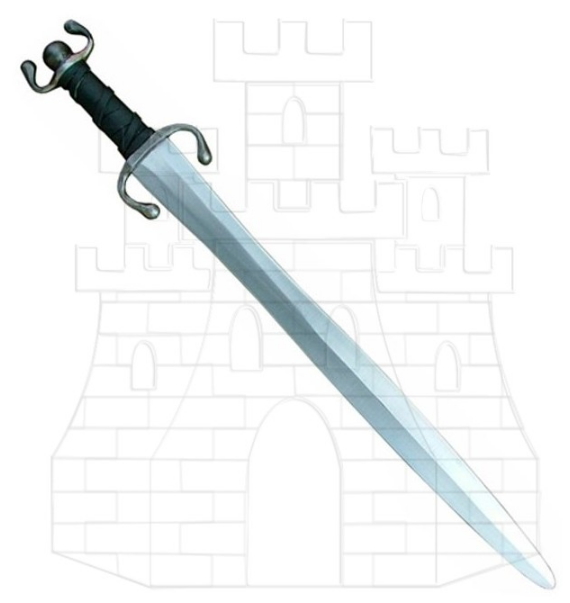
The proper maintenance of the blade is essential to maximize its lifespan and effectiveness. This maintenance includes regular practices of sharpening, cleaning, and the application of protective oils to prevent rusting. Neglecting these aspects can compromise the integrity of the weapon, resulting in ineffective performance, especially in critical situations. Careful maintenance not only prolongs the life of the blade but also enhances its overall performance during use. Additionally, this maintenance helps preserve the aesthetic and functional value of the weapon over time.
Finally, understanding the nature of the blade is fundamental, not only for collectors and enthusiasts of cutting weapons but also for martial artists and combat aficionados. Making informed decisions when selecting a blade involves considering a wide variety of factors ranging from combat techniques and personal preferences to the intended use, ensuring that each user finds the weapon that best suits their specific needs and objectives.
The groove, also known as blood groove, is a prominent feature found on a sword blade. This channel, which can vary in design, depth, and length, serves both practical and aesthetic functions in the construction and use of the sword, becoming a key element in its functionality.
From a practical standpoint, the groove has several important benefits:
- First of all, it reduces the weight of the blade, making it easier to handle and maneuver the weapon during combat.
- Secondly, by removing some of the material from the blade, it improves the balance of the sword, allowing for more precise control in its use.
- It also plays a crucial role in helping to prevent the blade from sticking to the bone when striking a target, which can be especially beneficial in combat situations.
- Additionally, the groove reduces air resistance, allowing the blade to move more quickly during motion, increasing its effectiveness in attack.
- Finally, this feature allows for blood and other fluids to drain from the blade, improving safety and ease of handling the sword, particularly in situations where these fluids could interfere.
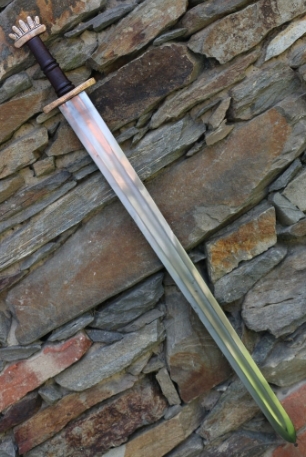
Regarding its aesthetic function, grooves offer significant visual appeal and can vary widely in design. Styles can range from simple and straight grooves to more complex and intricate patterns. These may include:
- Historical symbols, reflecting the cultural heritage and tradition of the specific sword model.
- Geometric patterns that add an artistic touch to the piece, making it visually stunning.
- Artistic figures that may tell stories or represent myths and legends associated with the sword.
Furthermore, grooves can be adorned with luxurious materials such as gold, silver, or even precious stones, enhancing their aesthetic appeal and collector value. When choosing a sword, it is important to consider the type of groove and how it relates to the user’s needs and preferences. A well-designed groove not only enhances the functionality of the sword but also highlights its beauty and may have a profound historical significance.
The handles of a knife are the side pieces that make up the handle, covering the tang of the knife, which is the metal part that extends from the blade to the end of the handle. These handles are essential not only for their structural function but also for their aesthetic and ergonomic impact on the use of the knife.
Generally, the handles are made from a variety of materials, including:
- Wood: Offers a traditional look and warmth to the touch, being a popular choice among knife artisans.
- Bone: Provides an elegant finish and can be crafted with artistic details.
- Leather: Offers a comfortable grip and is aesthetically pleasing.
- Plastic: Versatile and durable material, ideal for everyday use and easy to clean.
- Stainless steel: Although less common for handles, it can be used in modern and minimalist designs.
The handles not only enhance the aesthetics of the knife but also serve critical functions. They provide a secure grip, reducing the risk of slipping from the hands during use. They also protect the user from the sharp edges of the blade and the metal tang, thus offering greater safety in handling.
Moreover, the handles can be designed to improve ergonomics, adapting to the shape of the user’s hand, which is fundamental for prolonged activities, such as cooking or camping. A well-designed handle can minimize fatigue and increase precision in cutting.

Some handles feature elaborate designs that include textures, metal inlays, or even precious materials, increasing not only their visual appeal but also their value. However, regardless of the design, it is crucial that they be durable and wear-resistant for everyday use.
An interesting aspect is that in certain knife models, the handles are removable, allowing the user to replace or customize them according to their preferences. This feature not only provides an option for personalization but also facilitates cleaning and maintenance of the knife, thereby contributing to its longevity.
In conclusion, handles are a fundamental part of the design and functionality of a knife. They not only offer a secure grip and protection but also allow for a personalized approach that can enhance the user experience.
The bevel is a fundamental element in the design and functionality of bladed weapons, located on the edge of the blade. Its main function is to optimize the cutting capability of the weapon, providing a specific angle that allows for efficient cutting and piercing. The shape and angle of the bevel are critical in how the weapon interacts with different materials, which is crucial for its performance.
The variability in the angles and widths of the bevel depends on the type of weapon and its intended use. This means that each bladed weapon can present a unique bevel design tailored to its function. Below, we will explore several examples that illustrate the importance of the bevel in different contexts:
- Kitchen knife: This type of knife usually has a wider and less sharp bevel, enhancing precision when cutting soft foods like vegetables and fruits. This design facilitates smooth cutting and minimizes the effort required, making cooking a more enjoyable and efficient activity.
- Tactical knife: Unlike the kitchen knife, this knife features a narrower and sharper bevel, allowing it to easily penetrate hard materials. This characteristic makes it particularly useful in situations where deep and quick cuts are necessary, such as in survival activities or self-defense.

The shape of the bevel also varies significantly depending on the type of weapon. Some examples are:
- Japanese swords: Katanas feature a curved bevel, known as "hamon." This design not only has aesthetic appeal but also improves their cutting capability due to the distinctive shape of the blade, which allows the sword to make safe and effective cuts.
- Machetes: Typically, machetes have a straight and uniform bevel designed to maximize their effectiveness in cutting vegetation, such as grasses and branches. This type of bevel facilitates tasks in rural or jungle environments, where resilience and performance are essential.
The bevel is therefore a critical part not just of performance, but of the user's safety. It is vital to keep the bevel sharp, as a dull edge can decrease the weapon's effectiveness and increase the risk of accidents. An additional effort to make cuts may lead to a higher risk of injuries or damage to the equipment.
For this reason, it is essential to pay attention to the care and maintenance of the bevel, ensuring that these tools remain in optimal working condition. This not only guarantees the durability and effectiveness of knives, swords, and machetes but also contributes to safe and responsible handling of bladed weapons.
Always remember to follow the manufacturer's recommendations regarding sharpening and maintenance to ensure safety and performance in the use of your tools.
The dactilera is a very valuable design element found in some knives, located at the back of the handle, near the blade. This notch or depression provides an optimal place to position the index finger, significantly increasing control and maneuverability during use. With the dactilera, the user can enjoy a more secure grip, minimizing the risk of the hand accidentally slipping towards the blade, a crucial aspect in any activity that requires precise cuts.

One of the greatest benefits of using a knife with a dactilera is the ability to apply greater force while cutting. This is especially favorable in tasks that demand precision and safety, such as in the handling of hunting or tactical knives. Due to its design, these knives are used in situations that require extreme control, such as in food preparation or outdoor activities.
Moreover, it is not uncommon to find dactileras in certain kitchen knives, particularly in those designed for cutting meats, fish, or poultry. This feature is an excellent option for chefs and cooking enthusiasts looking to improve their technique and culinary experience.
It is important to note that the inclusion of the dactilera is a matter of design and personal preference. Not all knives incorporate this feature, and some users may opt for models without a dactilera depending on their cutting style and intended use. When choosing a knife, it is advisable to consider how it feels in the hand and the level of control that can be exerted without compromising safety.
In conclusion, the dactilera is a feature that can make a difference in the functionality and comfort of a knife, providing a firmer grip and increasing precision in cuts. When considering the purchase of a knife, evaluate your own needs and preferences, as well as the type of tasks you will perform. This will help you select the perfect knife that suits your expectations, ensuring a satisfying and safe user experience.
The spine of a knife is a fundamental part that refers to the section opposite the blade, that is, the back part of the knife that is not sharpened. It is often known as edge or back.
Understanding the importance of the spine is crucial, as it can influence the knife's effectiveness in various cooking tasks or in professional settings. For example, when making cuts in hard foods, the spine can provide a solid base that prevents the knife from slipping. Additionally, it is useful for giving light taps to objects without compromising the blade, which is essential for maintaining the knife's durability in the long term.

From a safety perspective, the way the spine is used can prevent accidents. By placing the knife on a flat surface with the blade facing down, the spine provides a secure backing, reducing the risk of injury. The variety in the spine design, which can vary in thickness, width, and curvature, allows each type of knife to have unique characteristics that adapt to its specific function. In certain knives, the spine can be almost as thin as the blade, while in others it can be more robust and thick, thus offering greater stability and strength.
The shape and design of the spine are also determinants depending on the intended use of the knife. For example, some knives have a completely straight spine for precise cuts, while others feature a curved spine that allows for greater cutting pressure. Additionally, certain models may include a sharpened spine, enabling them to act as a second edge in emergency situations.
In highly specialized contexts, such as diving knives, the spine may integrate additional features, such as a serrated section for cutting ropes or cables. There is also the possibility that the spine is designed to serve multiple purposes; some knives allow the spine to be used as a striking surface to drive nails or other objects, making them versatile tools both in the kitchen and in more demanding work environments.
Therefore, when choosing a knife, it is not only important to consider the blade but also the design and functionality of the spine, as these characteristics can significantly enhance effectiveness and safety during use.
The grip of swords is an essential component of the design and functionality of these weapons. It is the part of the handle located opposite the blade, allowing the user to hold and maneuver the sword effectively and safely. It is made from a variety of materials, which can include wood, metal, bone, ivory, and various synthetic materials, each of which contributes not only aesthetics but also grip and durability characteristics.
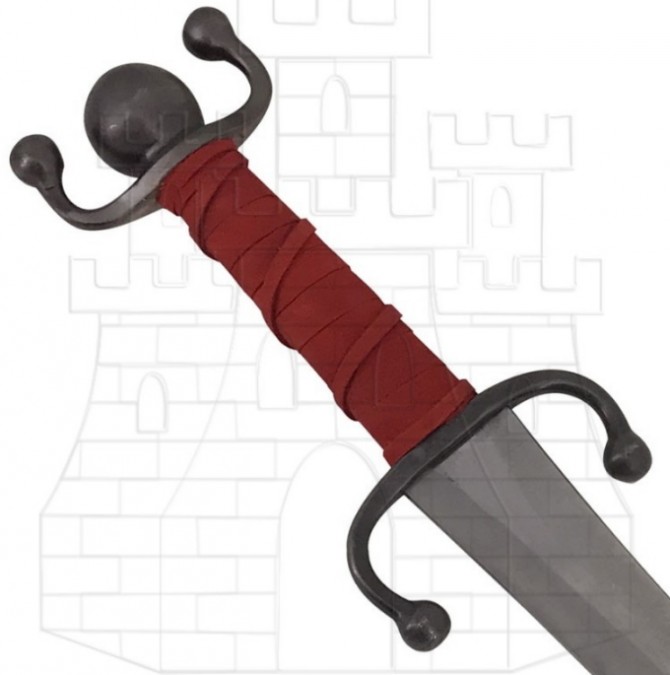
Beyond its practical aspect, the grip can also serve a decorative and representative function. Many designs include symbolism and historical figures, conveying a sense of heritage and legacy that can be significant for the bearer. Therefore, the selection of a sword's grip should consider not only the physical characteristics of the blade, such as its length, but also the diameter and the hand length of the user. This will ensure that the grip suits their personal needs, providing a more comfortable and effective experience.

The grip also plays a fundamental role in the balance of the sword. The correct weight distribution between the blade and grip allows the bearer to handle the weapon with greater ease and precision, which is essential in combat situations or during training. Some grips are designed in such a way that they can be used as a secondary weapon, thus expanding their functionality and utility in various circumstances. This ensures that the user is prepared to attack or defend themselves at any moment.
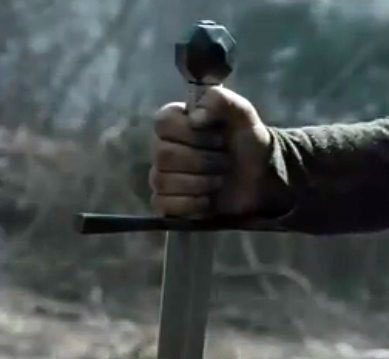
Grips are not exclusive to swords, but can also be found in a wide range of bladed weapons such as knives, daggers, machetes, katanas, and axes, among others. Each type of weapon will have its own grip shape and design to suit its specific use, providing a hold that maximizes effectiveness in combat. For this reason, it is always advisable to consider the characteristics of the grip when choosing any type of bladed weapon, ensuring that it not only fits the user's style but also meets the required safety and functionality standards.
The pommel of the sword is that fundamental part located at the end of the grip, opposite the blade. Although it may seem like a simple detail, its importance is much deeper than one might imagine. Pommel are made from various materials including wood, metal, ivory, bone, and others, offering not only an aesthetic function but also a vital practical contribution. They can be found adorned with a variety of designs that reflect the culture and purpose of the sword, merging art and functionality in fascinating ways.
From a practical perspective, the pommel plays a crucial role in the balancing of the sword. By counteracting the weight of the blade, it facilitates handling and precision during combat, allowing the user to execute maneuvers with greater skill. Not only that, but in situations where the blade cannot be used, the pommel can become a striking weapon, adding an extra layer of effectiveness to the sword.


- During the Middle Ages, pommels were used as secondary weapons, ideal for striking an opponent in situations where the blade could not be used, offering tactical versatility in combat.
- In certain swords, pommels were designed to facilitate the maintenance of the blade, allowing the bearer to disassemble the sword for cleaning and inspection.
- This component could also include symbolic figures or animals, such as lions and snakes, embellishing the sword and giving it a deeper meaning.
- Some swords were equipped with interchangeable pommels, allowing the same user to adapt to different situations using the same blade with different pommels.
- Pommels were also used as symbols of ostentation, to showcase the wealth and power of the owner, which was reflected in their decoration with jewels and precious stones.
- In cultures like the Celtic, pommels featured intricate designs, including geometric patterns and spirals that demonstrated artistic mastery.
- In Japanese swords, the pommel is called "kashira" and is commonly decorated with reliefs and engravings that reflect Japan's cultural heritage.
Together, the pommel of the sword is more than just a simple accessory; it is an element that encompasses history, culture, and functionality, elevating the art of fencing to truly impressive levels. When choosing a sword, considering the design and construction of the pommel will not only enrich its use but also its appreciation as an object of art and history.
The virola is a fundamental piece in the construction of swords and knives, located at the top of the handle, just before the blade. Also known as a collar or ferrule, this piece plays a crucial role in the integrity and functionality of the weapon. Its main function is to secure the blade to the handle, ensuring that it remains safe during use. Additionally, it acts as a protective barrier for the handle material, which is commonly wood, preventing wear and exposure to moisture that could compromise its durability.

Virolas can be made in a variety of materials, including brass, copper, stainless steel, or nickel. This not only influences the weight and strength of the knife or sword but also allows for a rich variety of styles and designs. In many cases, the virola becomes a decorative element in itself, adorned with intricate engravings and details that reflect the skill of the craftsman.

When selecting a virola, it is essential to consider the type of sword or knife, as well as the user's preferences. A well-designed virola not only ensures that the blade is securely held but also protects the handle from potential damage. Additionally, some virolas are designed to provide additional functions; for example, they allow for the blade to be removed for maintenance, which can be a deciding factor for collectors and serious users looking to prolong the lifespan of their weapons or kitchen utensils.
Finally, it is important to understand that while functionality will always be a priority, aesthetics also play a key role in choosing a virola. In a market where personalization is fundamental, many users opt for virolas that reflect their personal style or that match the overall design of their sword or knife.
Ceramic knives have revolutionized the world of modern cooking thanks to their unique properties and innovative design. These kitchen utensils are becoming increasingly popular, but it is essential to know both their advantages and disadvantages to decide if they are the right choice for you.
Advantages of Ceramic Knives
- Durable Sharpness: The ceramic blade, made primarily of zirconium oxide, retains its edge up to ten times longer than steel knives. This means less time spent sharpening, allowing for a smoother cooking experience.
- Lightweight: These knives are significantly lighter than metal ones, making them easier to handle and reducing fatigue when used for extended periods.
- Rust Resistance: Being a non-porous material, they do not retain odors or flavors and are completely immune to rust, making them ideal for cutting fresh fruits and vegetables.
- Precise Cuts: They provide fine and precise cuts, perfect for preparing delicate foods and dishes that require attention to detail.
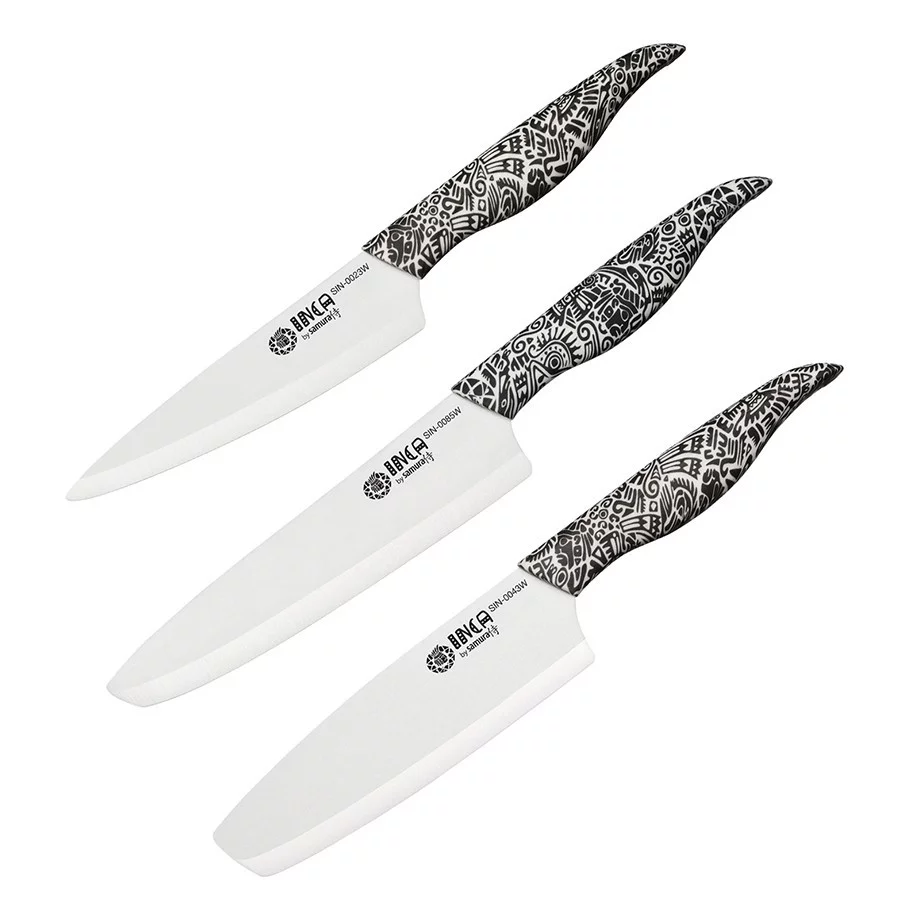
Disadvantages of Ceramic Knives
- Fragility: Unlike steel knives, ceramic ones are more prone to chipping or breaking if used improperly, especially when cutting hard foods or those with bones.
- Difficulty in Sharpening: To maintain their edge, they require a specific diamond sharpener, which can be a drawback for some users who are not familiar with this type of tool.
- Limitations in Use: They are not recommended for cutting hard foods like bones or frozen products due to their fragility. This limits their versatility compared to steel knives.
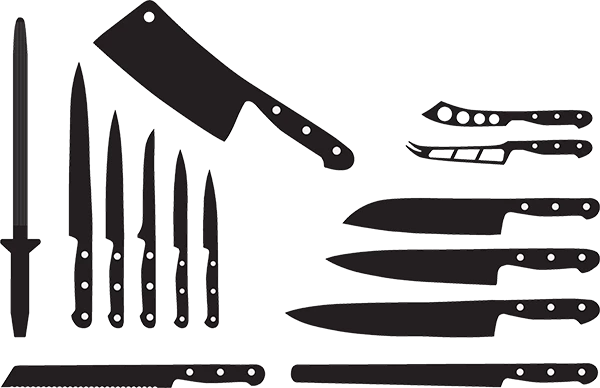
In conclusion, the choice between ceramic knives and steel knives depends on how they will be used and personal preferences. If you seek precision and minimal sharpening maintenance, ceramic knives are an excellent choice. However, if you require more robust utensils, steel knives may be the better option due to their strength and versatility.
The term recast is mainly related to the design and functionality of bladed weapons, such as swords and knives. This component is essential for the proper handling and use of these tools. Below, we will explore in detail what the recast is and its historical and technical importance.
Definition of recast: The recast is referred to as the unsharpened part of a knife or the intermediate section that connects the blade to the handle of a sword. This area is vital because it allows for a more secure and controlled grip, which is crucial during the use of the weapon.
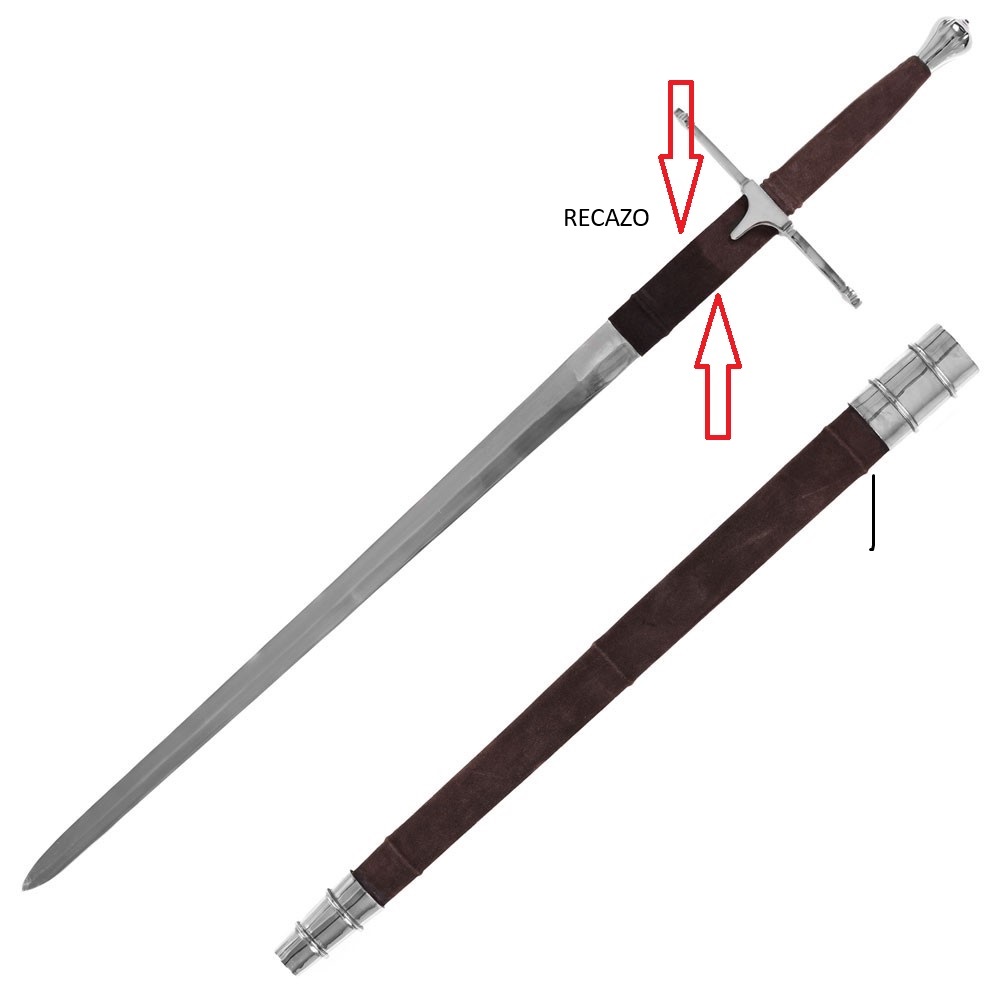
Historically, the recast has played a significant role in weapon design. In medieval and Renaissance swords, for example, this part of the weapon allowed the user to place their index finger over the guard, increasing strength and control when handling the weapon. This ergonomic design contributed to precision and effectiveness in combat.
Besides its practical function, the recast also involves aesthetic aspects in the art of weapon making. Artisans often decorated this part with engravings or ornamental details, adding visual value to the swords and knives they crafted.
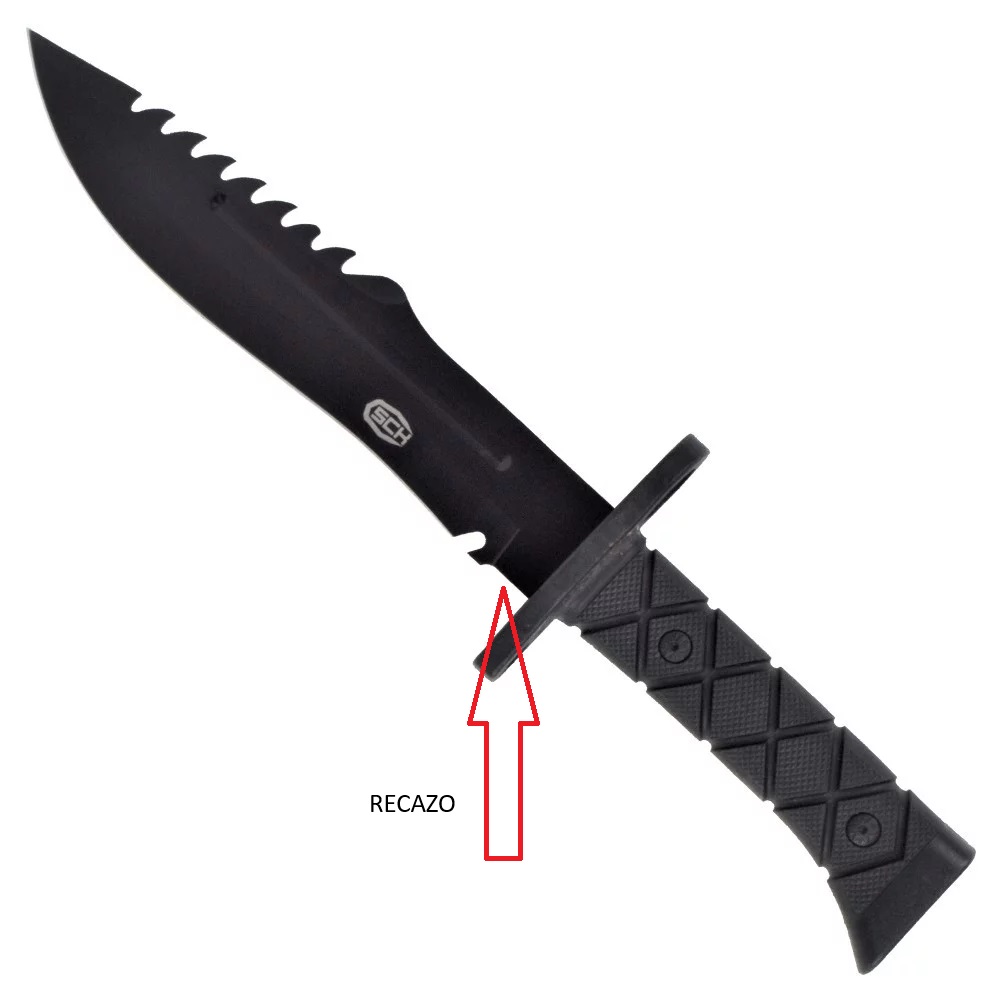
- Importance of recast in combat: A good recast design provides the user with superior control and better maneuverability of the weapon.
- Aesthetic aspects: The recast can also be a customization element, reflecting the artisan's skill and the user's style.
In summary, the recast is not only a functional part of weapons but is also associated with skill, tradition, and aesthetics in the crafting of swords and knives, elements that have accompanied humankind throughout history.
Damascus Steel is a legendary material in the metallurgy world, famous not only for its exceptional strength but also for the beautiful patterns it displays on its surface. This steel has a history dating back to ancient times, specifically in India, and has evolved over time, becoming a symbol of quality and durability.
Origins of Damascus Steel
The beginnings of Damascus Steel can be traced back to India, where a type of steel known as Wootz steel was first produced around 300 BC. This steel was noted for its high carbon content and unique band patterns that appeared to flow like water. Its popularity grew and eventually reached the Middle East, where Persian and Arab blacksmiths refined their manufacturing techniques. The name 'Damascus Steel' is linked to the Syrian city, a significant trade center in ancient times.
Unique Characteristics
Damascus Steel is particularly valued for:
- Durability: Its composition and manufacturing method make it wear-resistant.
- Exceptional sharpness: Knives and tools made from this steel maintain a very sharp edge.
- Beautiful patterns: The distinctive designs are the result of a forging process involving repeated folding and twisting of the metal.
The patterns can vary from simple wavy lines to complex designs that evoke elements of nature, adding aesthetic value to the final product.
Manufacturing Process
The traditional manufacturing of Damascus Steel requires a meticulous process:
- Alloy composition: An alloy of steel with high carbon content is produced, starting with the melting of iron and coal in a crucible.
- Layered reinforcement: In modern manufacturing, different types of steel are welded together under heat and pressure, creating multiple layers that enhance strength and flexibility.
This process is carried out carefully to ensure the quality and uniformity of Damascus Steel.
Contemporary Applications
Today, Damascus Steel is highly valued in the manufacture of:
- Kitchen knives: Known for their fine edge and corrosion resistance.
- Precision tools: Its durability makes it ideal for a variety of industrial applications.
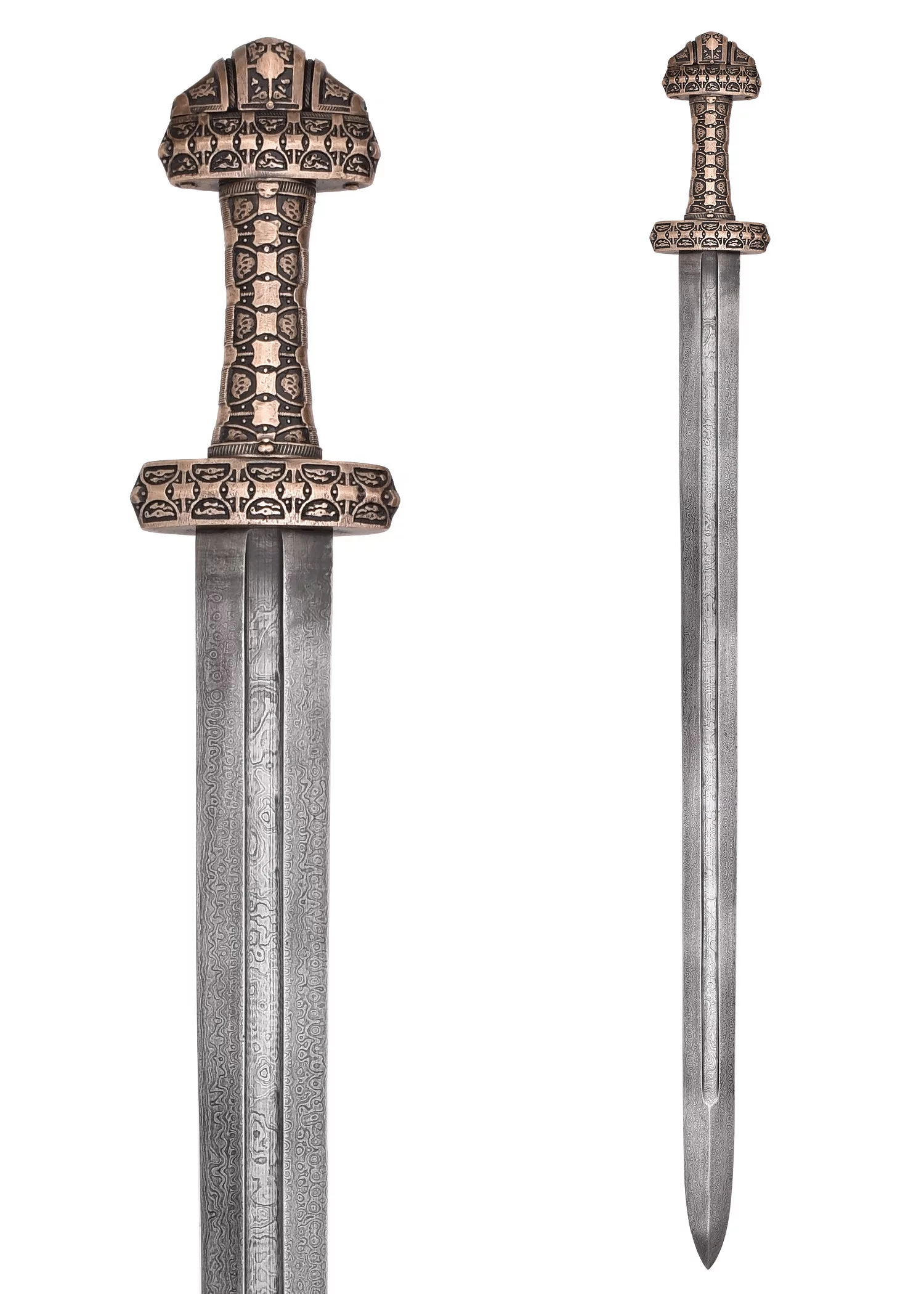
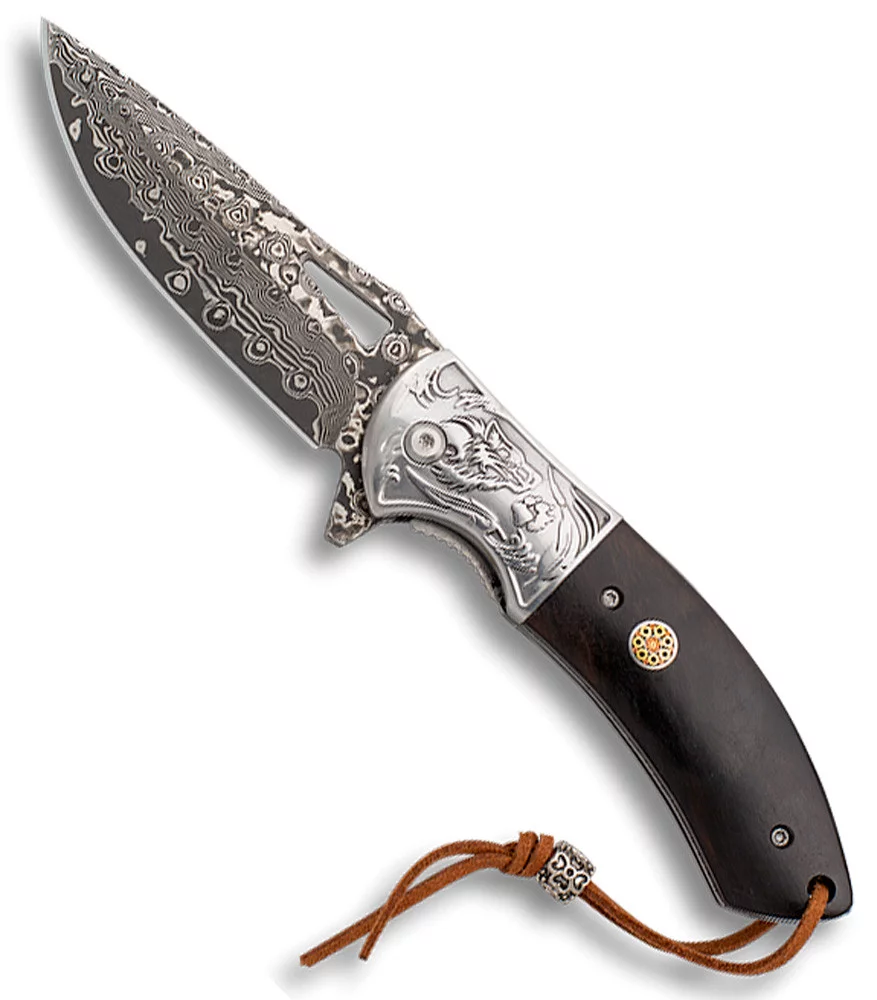
Thus, Damascus Steel not only represents a legacy of tradition and skill but also continues to impact the quality and aesthetics of contemporary tools and weapons, maintaining its status as a highly desirable material in various industries.
A **Full Tang** knife is a type of knife known for its robust and functional design. The key feature of these knives is that the handle is made continuously with the blade, creating a solid and durable piece. This construction provides significant advantages in terms of durability and performance, making them ideal tools for various activities, from cooking to survival situations.
History and Origins
The concept of the Full Tang knife has its roots in antiquity, where the manufacture of cutting tools was essential for human survival. From the first knives made by man, this design has been used in various cultures and eras, adapting to the needs of each specific use.
Characteristics of the Full Tang Knife
- Continuous Design: The handle and blade are integrated, eliminating any possible point of failure between both parts, thereby increasing the knife's strength.
- Strength and Durability: Its construction allows them to withstand pressure and impacts, making them suitable for demanding tasks without the risk of breakage.
- Survival Function: Designed for natural environments, these knives are ideal for cutting, carving, and performing other critical tasks during outdoor activities.
- Quality Materials: Most Full Tang knives are made with high-quality steels, giving them excellent cutting ability and resistance to corrosion.
- Functional Accessories: They often come with appropriate sheaths that allow for safe and practical transport, along with additional safety features, such as locking systems.
Examples of Full Tang Knives
Some notable Full Tang knives include:
- Gerber Prodigy Survival Knife: With a blade of 12.06 cm and ceramic coating, it is ideal for various conditions and features friction locks.
- Defender Xtreme Knife: With a 12-inch blade, it is perfect for camping and survival activities, equipped with a strategic sheath for transport.
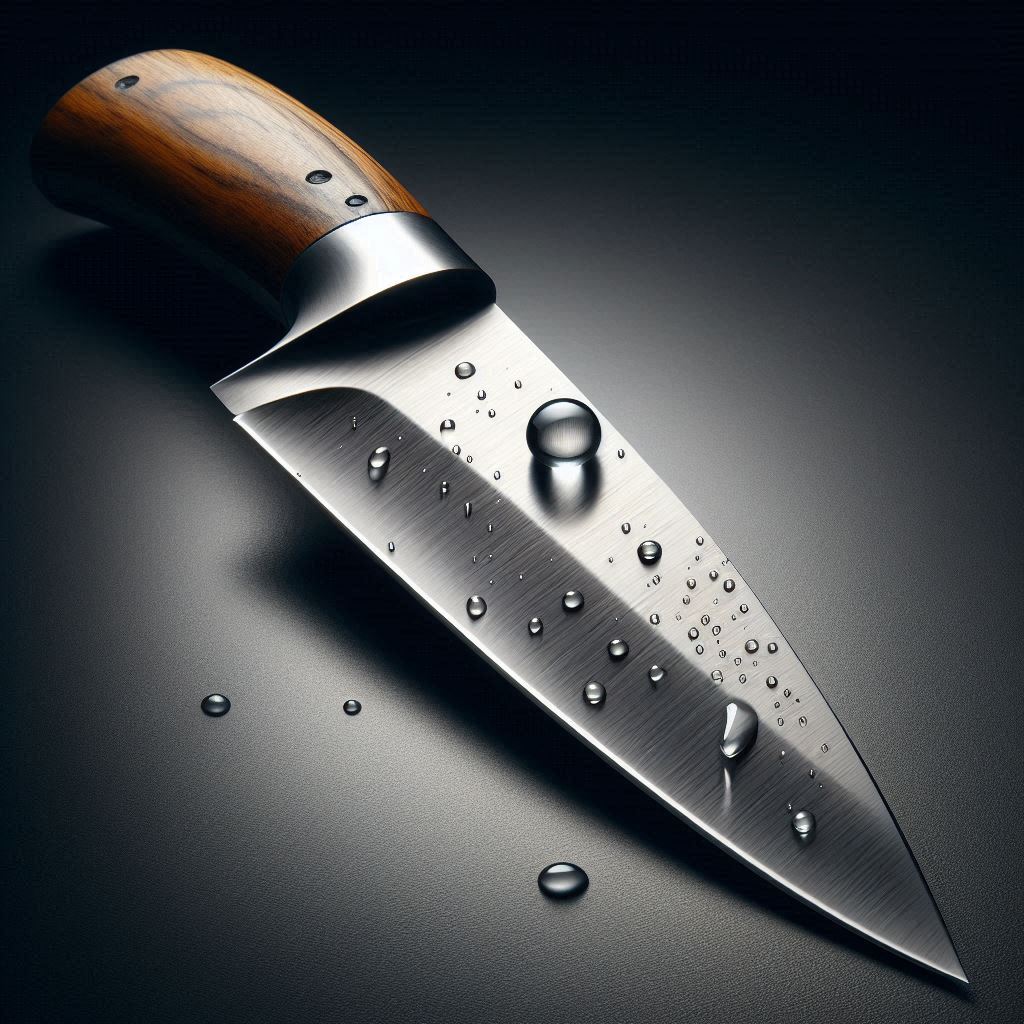
Use and Applications
Full Tang knives are widely used in various practical applications. Their robust design makes them ideal for:
- Hunting and fishing.
- Preparing food in rural settings or on the go.
- Making cuts in survival situations, such as skinning animals or creating shelters.
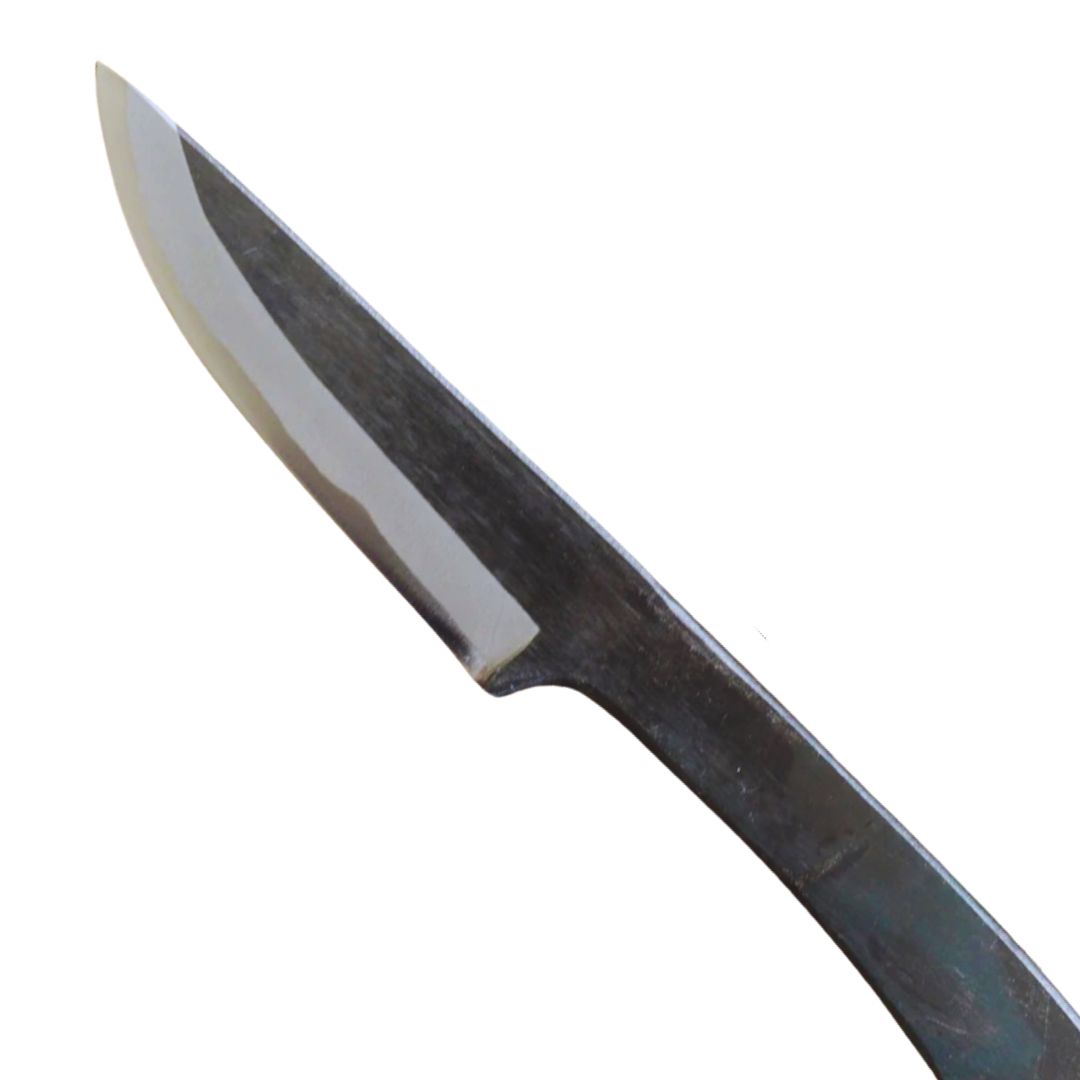
When choosing a Full Tang knife, it is essential to consider factors such as the blade material, cut profile, and the treatment it has received to ensure optimal and lasting performance.
When we talk about essential tools for bushcraft and survival, knives play a crucial role. Although often confused, bushcraft and survival knives are distinct in design, functionality, and applications. Knowing their differences will help you choose the best option based on your needs.
Key Differences between Bushcraft and Survival Knives
- Blade Length and Width:
- Survival Knives: Typically have longer and wider blades, which facilitate batoning for chopping logs and performing heavy tasks.
- Bushcraft Knives: Feature smaller blades, with a Scandinavian edge ideal for skinning and working with wood.
- Design and Ergonomics:
- Survival Knives: Focus on ergonomic grip to minimize injuries during prolonged use.
- Bushcraft Knives: Have a more classic and functional design, allowing for endless uses in natural environments.
- Materials and Resistance:
- Steel: Both types generally use carbon steel. However, survival knives require greater resistance for demanding tasks.
- Laminated Steel: Some bushcraft knives include this type, combining carbon and stainless steel for increased corrosion resistance.
- Handle Materials:
- Wood: Provides aesthetics and good grip, especially when treated.
- Micarta and G10: Durable composites that ensure excellent grip, ideal for intense use.
- Polymers and Leather: Are strong options, though with different grip and aesthetic characteristics.
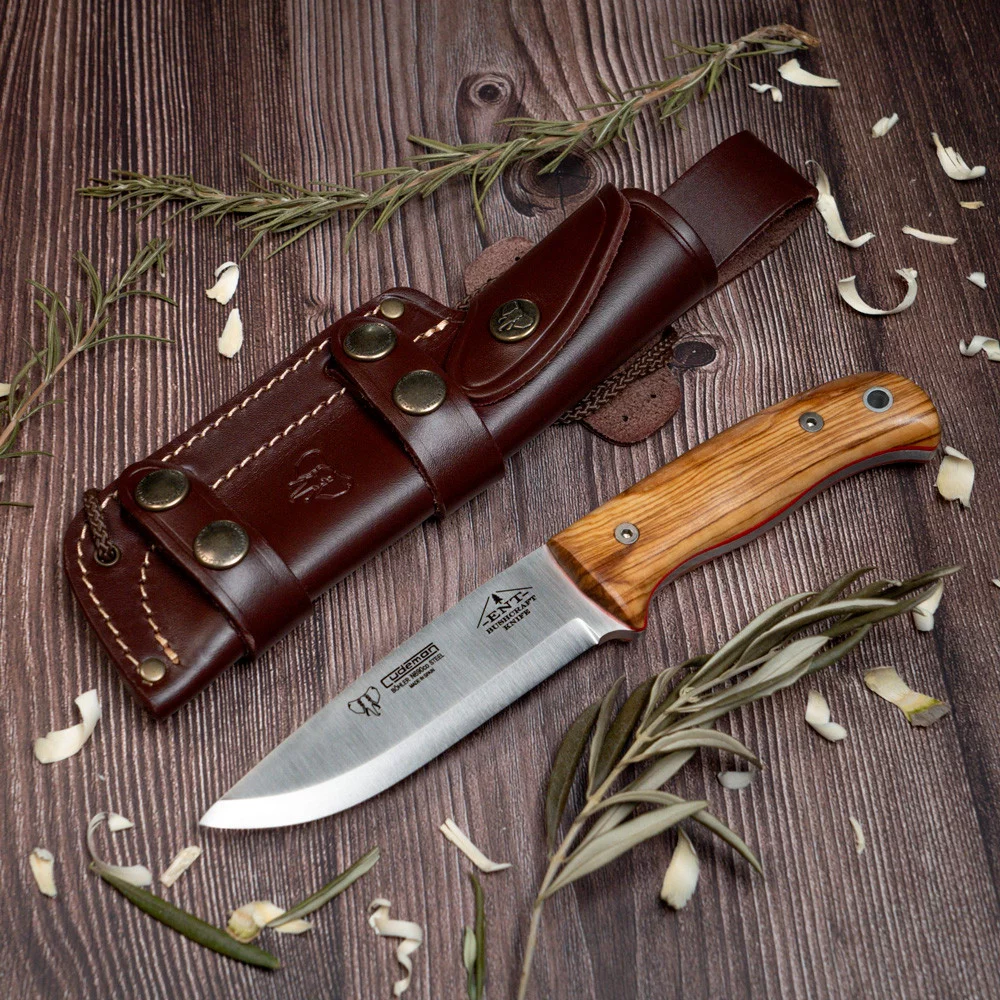
Advantages of Each Type of Knife
Bushcraft Knives
- Versatility: Ideal for multiple tasks, from cutting to carving.
- Durability: Withstand adverse conditions without losing effectiveness.
- Efficiency: Their design maximizes performance and control.
- Manageability: The ergonomic grip ensures comfortable and prolonged use.
Survival Knives
- Resistance: Designed to cut branches and perform tough work.
- Ergonomics: A secure grip is vital in critical situations.
- Ease of Maintenance: Generally, their carbon steel can be easily sharpened.
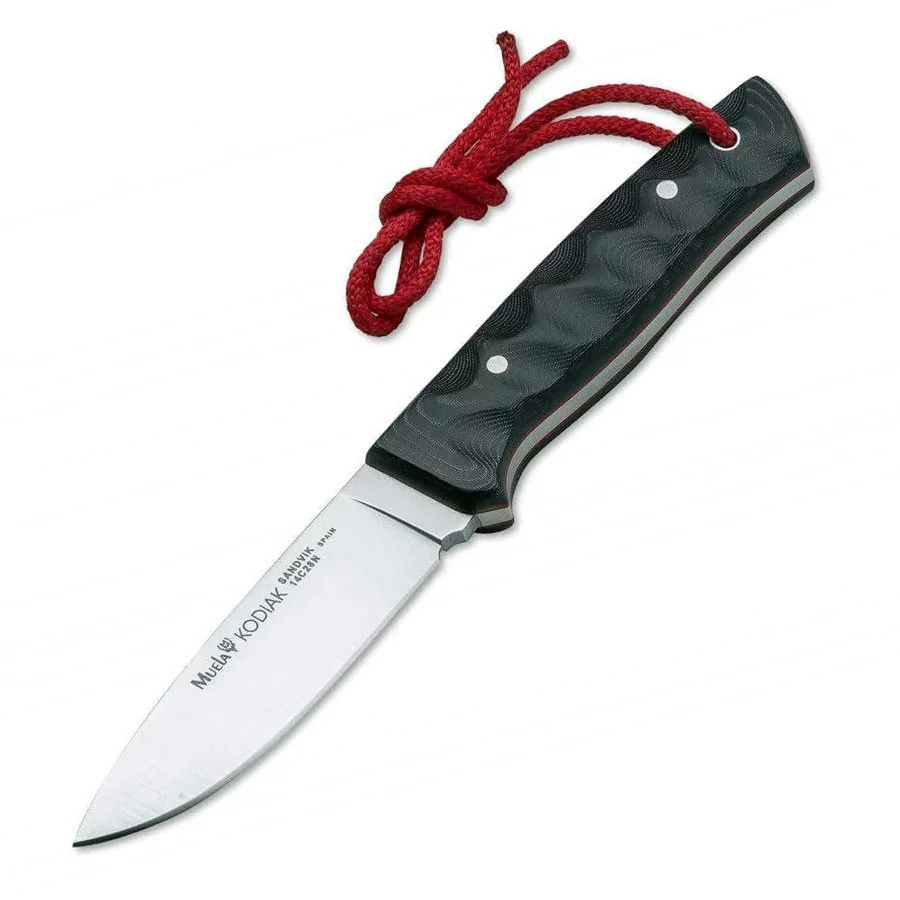
When evaluating both knives, consider your usage style and the scenarios you plan to engage in. Whether for bushcraft or survival situations, having the right knife can make a big difference in your outdoor experience.
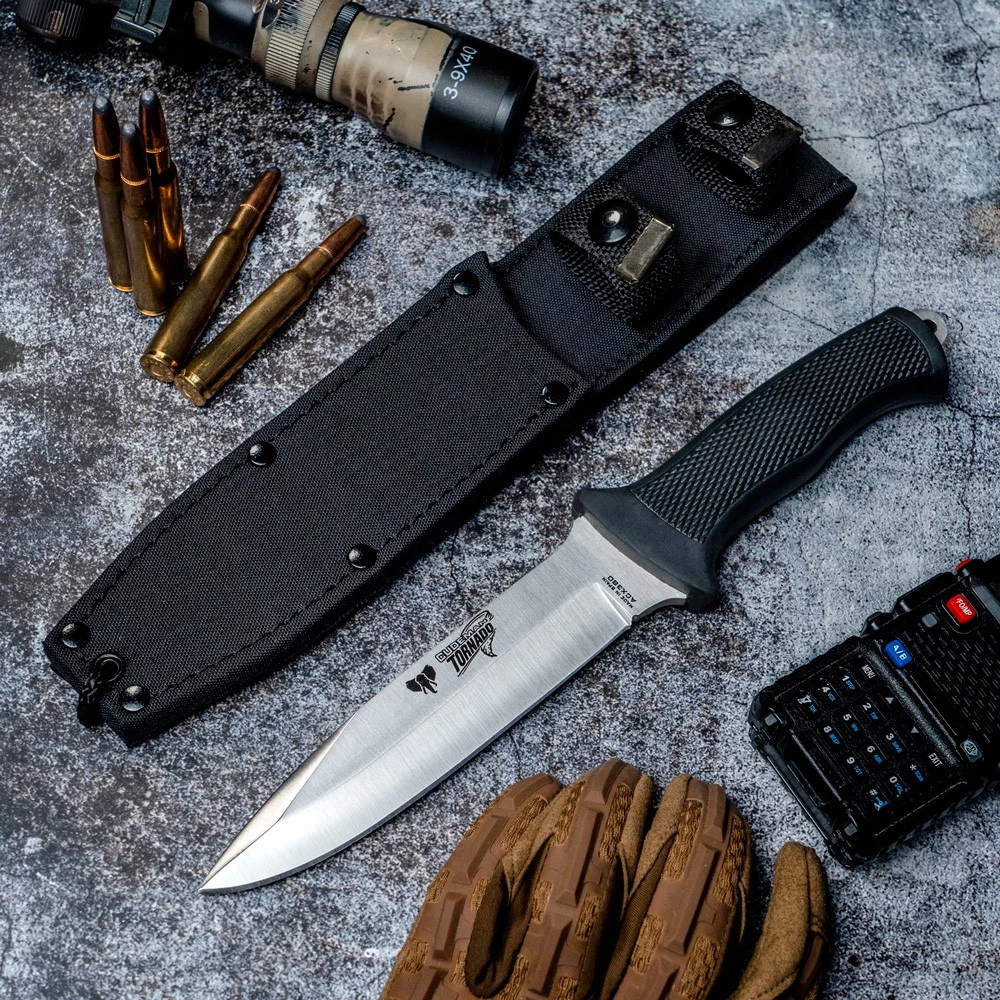
The hunting knife is a fundamental tool in the practice of hunting, designed to fulfill a specific and crucial function: to effectively and controlled kill the prey. Its robustness and precision make it an indispensable tool for any hunter seeking to carry out their activity ethically and safely.
Characteristics of the Hunting Knife
- Blade and Shape: The typical blade length is around 20 centimeters, although it may vary depending on the model. Blade shapes include full-tang, hidden-tang, and varied designs such as cow tongue, triangular, or pear, each adapted to different needs of use.
- Materials: Hunting knives are made with high-quality steels, such as stainless steel or damascus steel, providing them with remarkable durability and resistance to wear.
- Use and Application: This tool is used to finish the hunt rapidly and safely. It's crucial that hunters receive proper training to handle the hunting knife effectively.
- Brands and Models: There are several well-known brands in the sector, such as Muela, Albainox, and Nieto, offering a wide range of models, some of which are highly sought after by collectors.
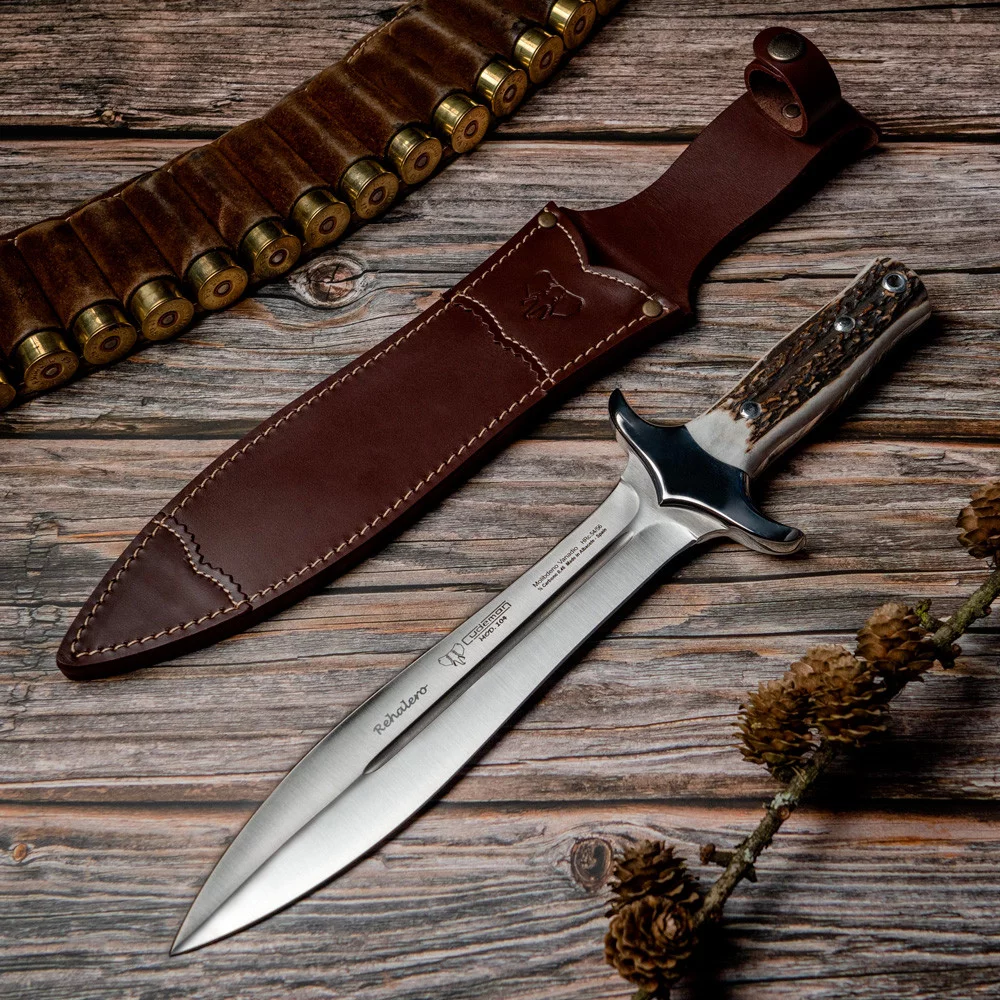
Advantages of the Hunting Knife
- Precision and Efficiency: Designed to operate with maximum accuracy, they reduce the time and effort needed in the hunting finishing process.
- Safety: As dedicated tools for this task, they minimize the risk of accidental injuries to both the hunter and the prey.
- Durability: Thanks to their superior quality materials, these knives are designed to last and require little maintenance, making them a long-term investment.
Legal Aspects to Consider
- Hunting Regulations: Hunters must be well-informed about local and national regulations related to the use of hunting knives. In many jurisdictions, there are laws regulating the types of tools allowed in hunting.
- Personal Safety: Handling sharp tools, including hunting knives, should always be done with proper precautions and after adequate training to ensure the hunter's safety and those around them.
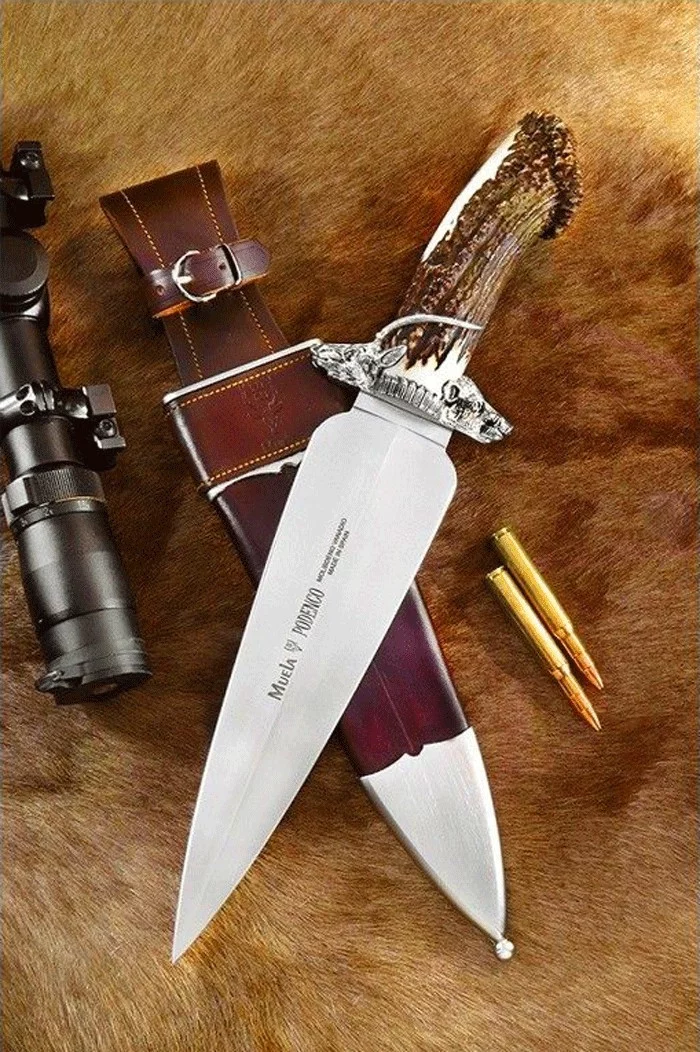
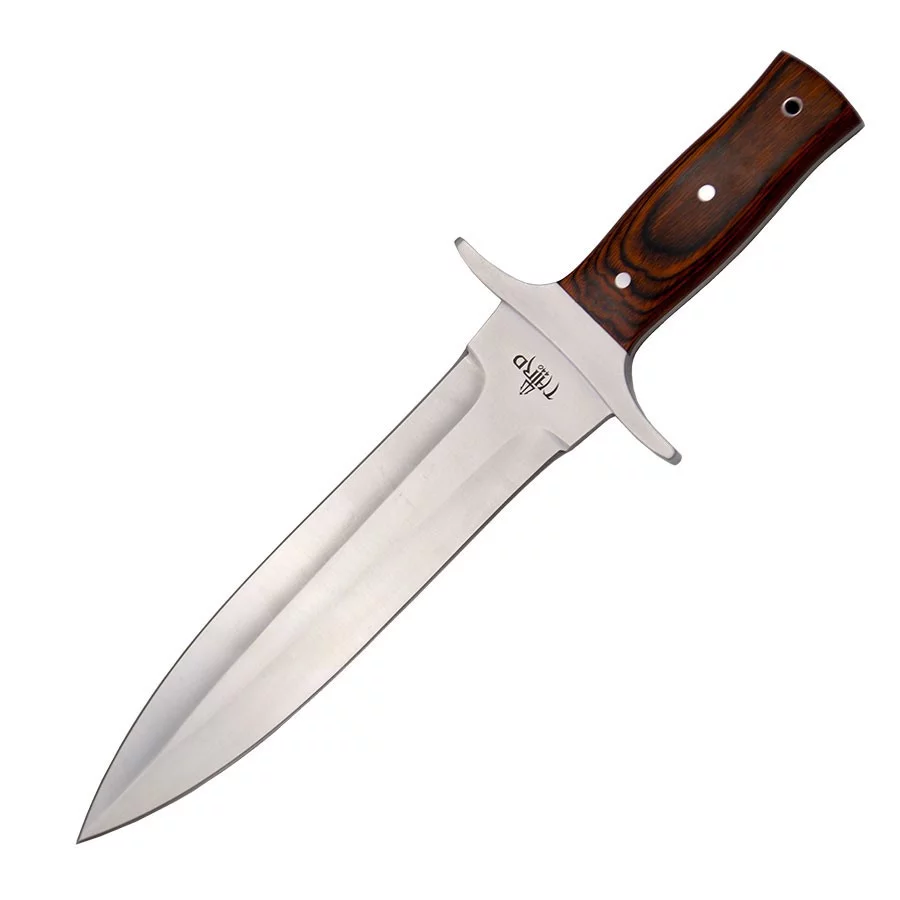
The Bowie knife is an iconic piece in American culture and a combat weapon that has been used in various activities over time. Originally designed in the 19th century, its essence transcends as a symbol of resilience and survival in the historical context of the American West.
Origins and Design
The Bowie knife was conceived by Rezin Bowie in honor of his brother, James Bowie, a renowned duelist. The story goes that James became famous in the duel known as the Sandbar Fight, where he used a large knife.
The features of the Bowie knife are quite distinctive:
- Blade Length: Ranges between 8 and 12 inches (20 to 30 cm).
- Width: Approximately 1.5 to 2 inches (4 to 5 cm).
- Clip Point: Facilitates effective cuts and thrusts.
- Cross Guard: Provides protection to the user's hand.

Evolutionary Characteristics
Since its creation, the knife has evolved in terms of design and functionality. The first versions were simpler, but over time the following features were added:
- Clip Point: Enhances control in thrust attacks and cutting capabilities.
- False Edge: A sharpened upper part that aids penetration.
- Diverse Materials: From basic to high-end steels, and some even incorporate soft metals for greater durability.
Functionality and Relevance
The Bowie knife was not only a weapon but a multifunctional tool for pioneers. It was used for:
- Hunting and skinning animals.
- Cutting wood.
- Personal defense.
In terms of symbolism, it has represented bravery and the spirit of survival, appearing in historical moments like the Battle of the Alamo, consolidating its cultural importance.
Modern Variations and Styles
Over the years, the Bowie knife has taken on various forms, including:
- Classic Bowie: With its famous clip point and long blade.
- Tactical Bowie: Adapted for military use, with ergonomic designs and high-resistance materials.
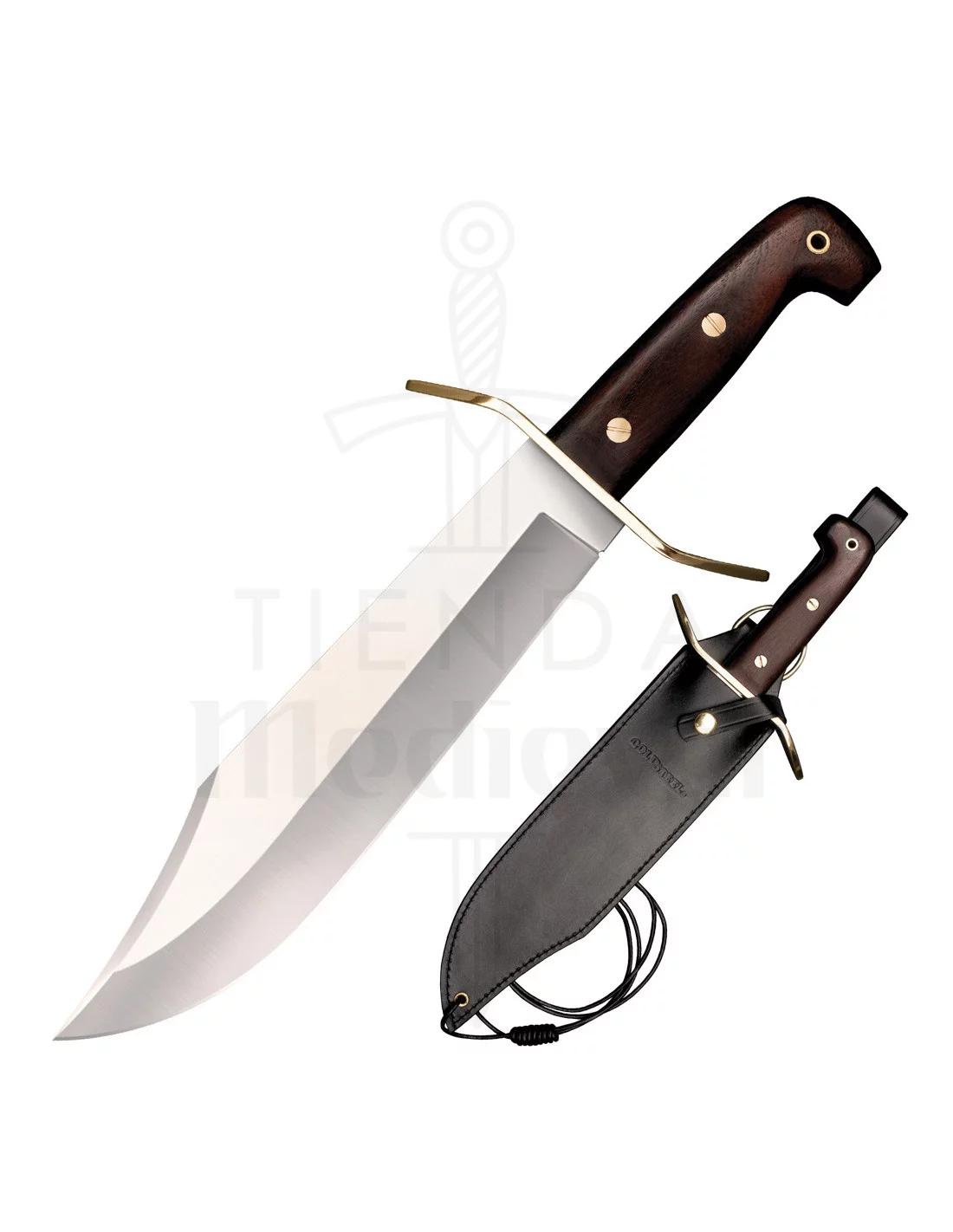
Conclusion
The Bowie knife embodies not only an iconic design but a cultural legacy of bravery, resilience, and adaptability, reflecting the history and spirit of those who inhabited and explored the American West.
| Type of Bowie Knife | Key Features | Common Use |
|---|---|---|
| Classic Bowie | Long blade, clip point | Hunting, personal defense |
| Tactical Bowie | Ergonomic designs, durable materials | Military and police use |
| Ornamental Bowie | Elaborate designs, decorative elements | Exhibition and collection |
A skinner knife, also known as a Skinner knife, is a specialized tool used to separate the skin of game animals from their meat. This tool is essential both in the hunting process and in meat processing, allowing for efficient and careful skin extraction while minimizing the risk of damaging the meat underneath.
Characteristics of a Skinner Knife
Skinner knives have several distinctive features that make them ideal for their function:
- Curved and Short Blade: The blade is generally short and features a curvature that allows for precise and controlled cuts, which is vital when separating the skin without affecting the meat.
- Sharp Edge: A well-sharpened edge is essential for making clean cuts, ensuring ease of operation, and reducing the possibility of accidents.
- Ergonomic Handle: Many models have handles designed for a comfortable and secure grip, helping to maintain control of the knife during the skinning process.
Types of Skinner Knives
Within the world of skinner knives, there are various models adapted to different uses:
- Big Game Knives: These are usually more robust and larger, designed to handle animals like deer or boars.
- Small Game Knives: These are lighter and smaller, ideal for skinning animals like rabbits or birds.
- Knives with a Hook: Some variants include a hook that holds the skin, facilitating the skinning process.
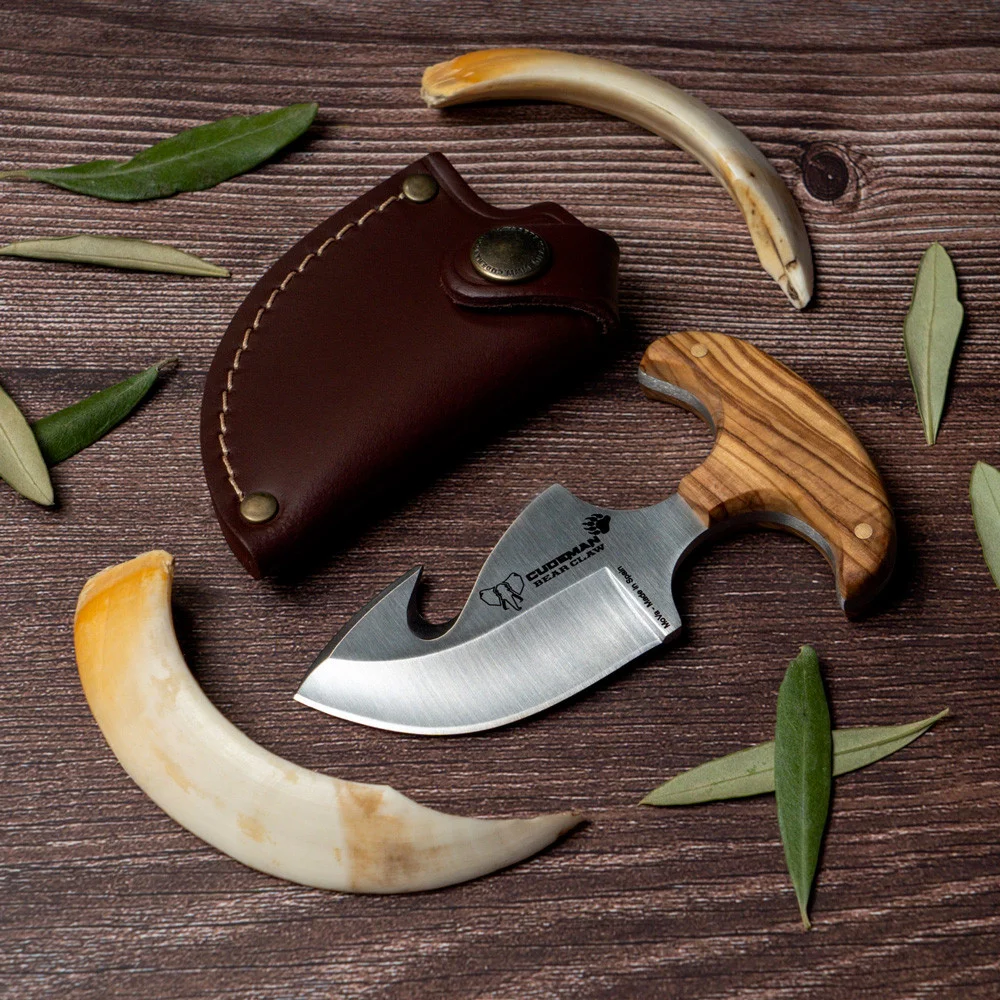
Advantages of a Skinner Knife
Using a skinner knife offers several key advantages:
- Makes Skinning Easier: Simplifies the process of separating the skin from the meat, optimizing the use of the prey.
- Minimizes Risk of Accidents: Its design prevents unwanted cuts that may affect the quality of the skin.
- Versatility: Many skinner knives can be used for other tasks in the kitchen, such as boning or trimming, making them multifunctional tools.
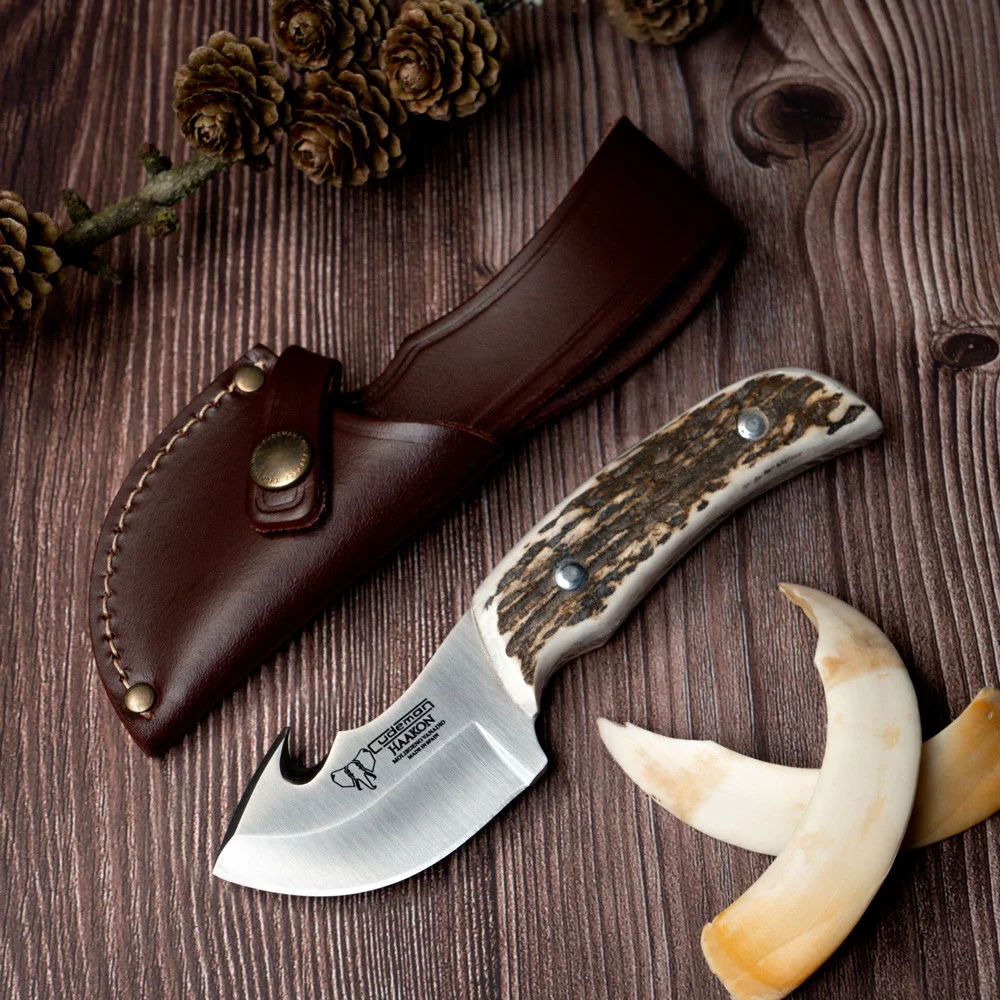
Examples of Skinner Knives
Some popular options in the market include:
- Vittorio Professional Skinner Knife: Known for its curvature that perfectly fits the contour of the animal.
- Buck 685 Bucklite Max II Skinner Knife: With a hook-shaped blade, ideal for skinning and other outdoor tasks, made with 420HC steel that guarantees corrosion resistance.
| Model | Type | Material |
|---|---|---|
| Vittorio Professional | Big Game Skinner | Stainless Steel |
| Buck 685 Bucklite Max II | Small Game Skinner | 420HC Steel |
The Kukri knife, also known as khukuri, is a traditional tool and weapon originating from Nepal. This distinctive knife is especially recognized for its association with the Gurkha warriors and has been deeply integrated into Nepali culture and traditions. Its shape and design have made it an object of admiration and respect over the years.
Origin and Historical Context
The history of the Kukri knife is fascinating and somewhat controversial. It is believed that its design may derive from an ancient Hindu sword called nistrimsa (निस्त्रिंश), with influences from the Greek kopis brought by Alexander the Great. The Kukri has played an active role in historical conflicts, such as the Anglo-Nepalese War and participation in World War I and World War II, cementing its status as a symbol of bravery and resilience.
Essential Features of the Kukri
One of the most notable features of the Kukri knife is its curved and heavy blade:
- The blade usually measures between 40 and 45 cm.
- The weight varies from 450 to 900 grams, providing a balance that facilitates handling.
- Its design is meant for deep and efficient cuts.
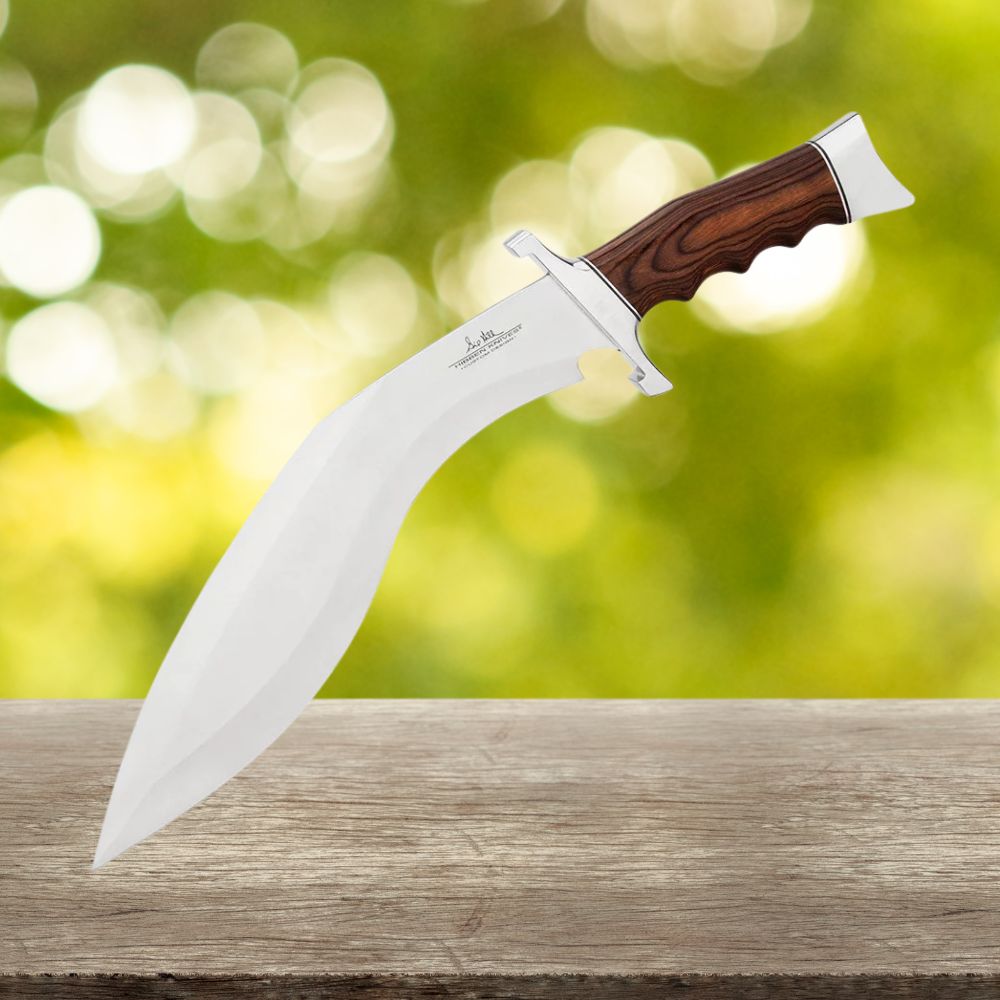
The Design and Construction Process
The traditional Kukri is crafted with high-quality materials. The handle, generally made of hard wood or horn, is designed to provide a comfortable and secure grip. A natural adhesive called "laja," incorporating plant resins and beeswax, is used to join the handle to the blade. Additionally, it features a crescent-shaped notch, known as "cho" or "kauri," which holds important symbolic significance.
Use and Versatility
This knife has multiple applications:
- In combat, its curved design allows for powerful and precise cuts.
- In survival situations, it is useful for tasks such as cutting, chopping, skinning animals, and also in carpentry or construction work.
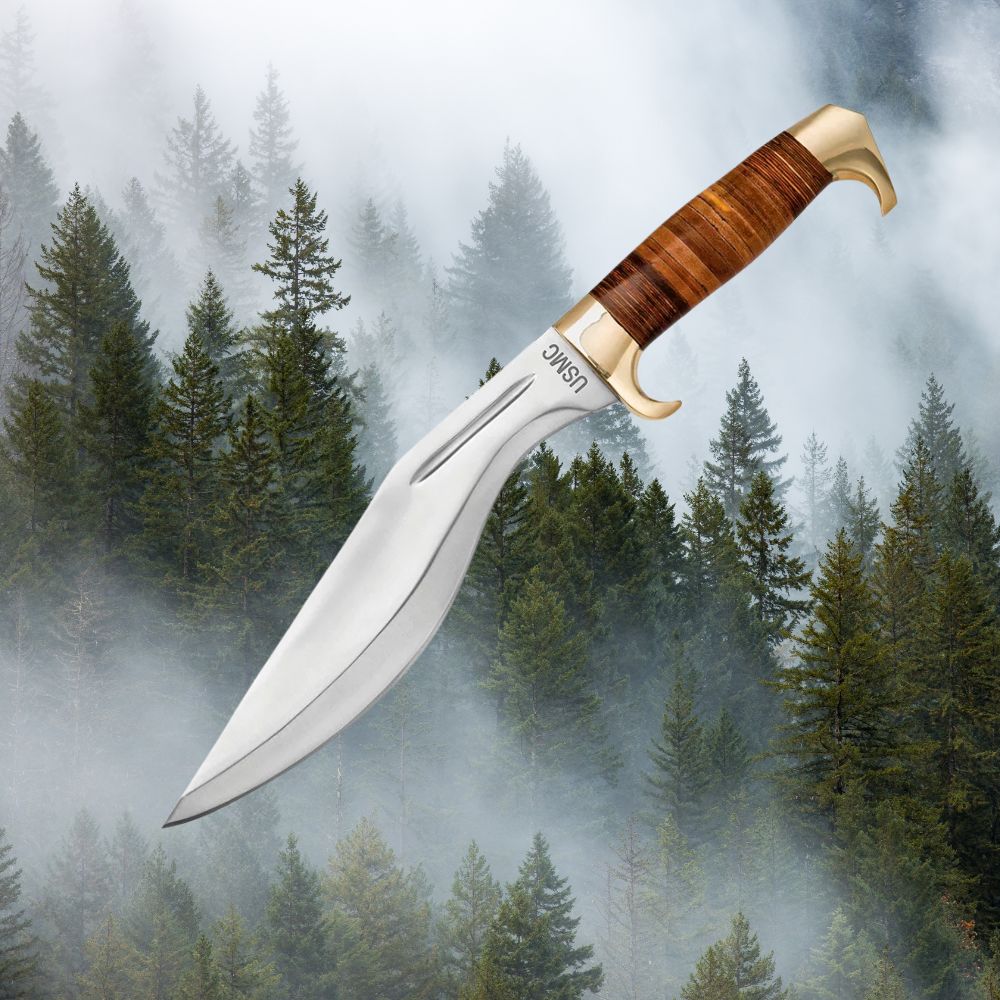
Cultural and Social Significance
The Kukri is not only a functional tool, but it also holds deep cultural significance in Nepal. It is considered an essential item in households, used as a means of protection and as an object of great historical and emotional value. Additionally, collectors especially value ancient specimens, appreciating their craftsmanship and the legacy of Nepali culture.
| Features | Specifications |
| Blade length | 40-45 cm |
| Weight | 450-900 grams |
| Handle material | Hard wood or horn |
| Adhesive | Laja (plant resins and beeswax) |
| Cultural presence | Symbolic and protective element |
The Santoku knife is a highly renowned kitchen tool, originating from Japan, which has gained popularity in kitchens around the world thanks to its versatility and efficiency. Its name, "Santoku", translates to "three virtues" or "three uses", referring to its three main functions: slicing, dicing, and mincing.
Origin and Meaning
This Japanese knife is often compared to the Western chef's knife, though it is characterized by being shorter and lighter. Its design reflects Japanese culinary tradition and its focus on precise food preparation, highlighting its use for meat, fish, and vegetables.
Distinctive Features
- Blade Design: The Santoku blade is generally straight and without a tip, resulting in more controlled cuts.
- Length: The blade usually measures between 13 and 20 cm, with the most common being 16 to 18 cm.
- Grantons: Many models feature air pockets that help prevent food from sticking to the blade during cutting.
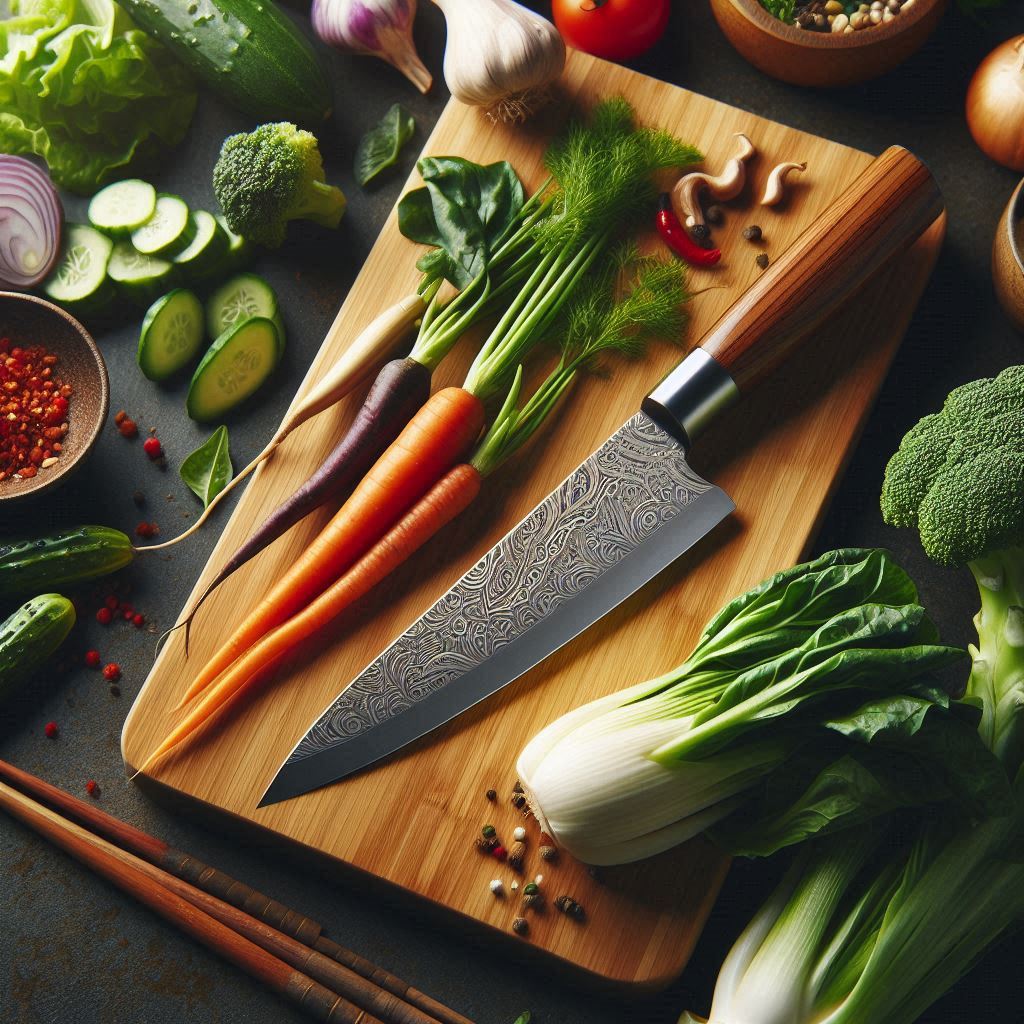
Materials and Care
Santoku knives can be made from various materials, notably:
- Stainless Steel: Ideal for those seeking low maintenance.
- Carbon Steel: Offers impressive sharpness, although it requires more care.
- Ceramic: Lightweight and durable, but with less versatility.
To maintain its quality, avoid washing it in the dishwasher. It is recommended to use a protective sheath called "saya" to prolong its life.
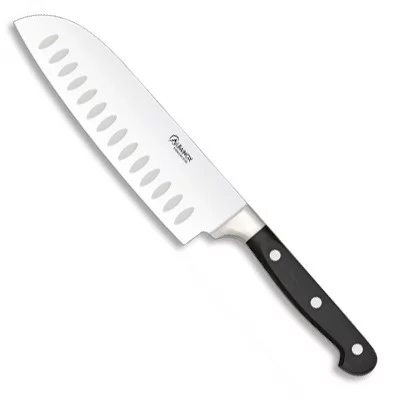
Purchase Tips
If you are considering buying a Santoku knife, keep in mind:
- Material Quality: Opt for high-quality Japanese steel, such as VG10.
- Ergonomics: A well-designed handle enhances the user experience.
- Budget: Prices vary, from more economical models to premium options that can exceed 200 €.
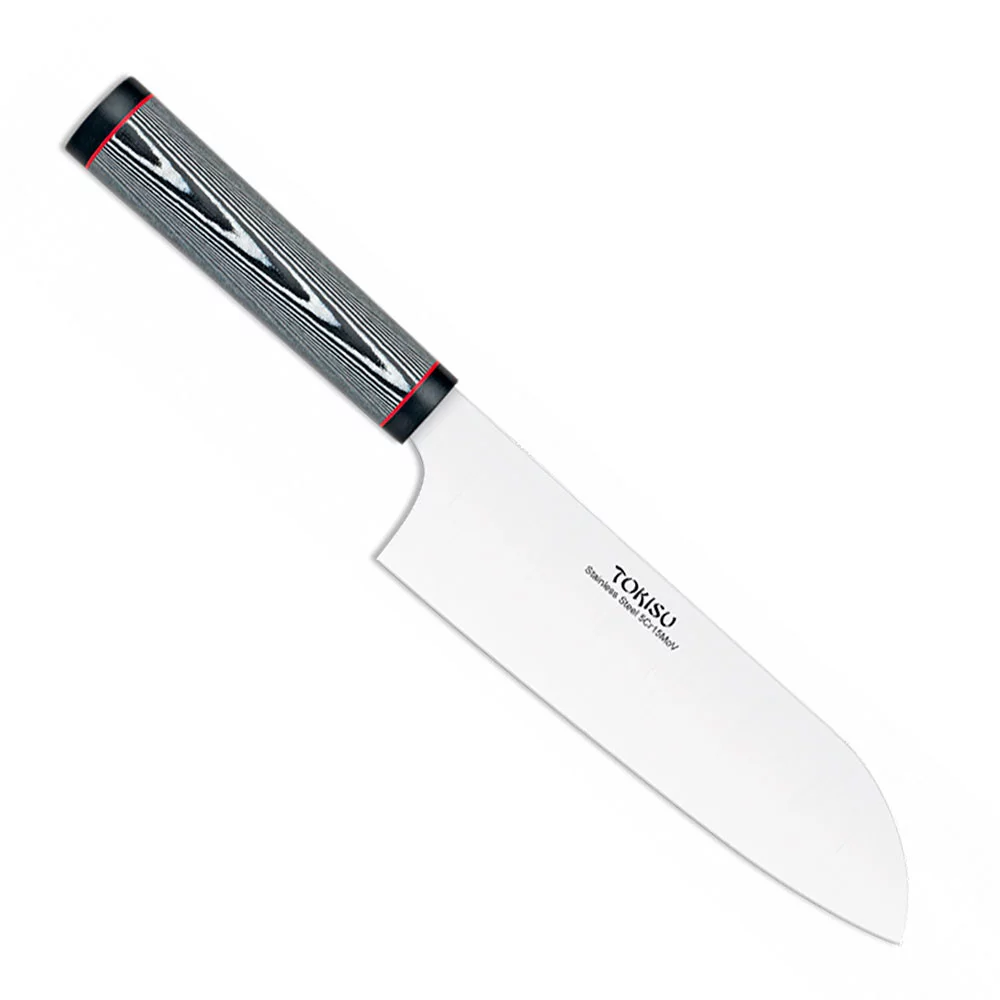
The hollows on a knife are small indentations or grooves designed on the blade of knives to enhance cutting efficiency for various foods. This feature, present in many kitchen knives, is particularly useful in preventing food from sticking to the blade while cutting.
Origin and Functionality
The incorporation of hollows in knives has its roots in Nordic countries, where the need to cut sticky foods, such as salmon, led to this innovative solution. The indentation on the blade not only aids in making more precise cuts but also contributes to the speed of the process by reducing resistance.
Benefits of Hollows
- Ease of Cutting:
The hollows create a layer of air between the knife blade and the food, which reduces friction and facilitates cutting. This is particularly advantageous for sticky foods, such as ham and certain cheeses.
- Prevention of Adhesion:
By preventing food from sticking to the blade, the hollows allow for more precise and clean cuts. This results in a more refined presentation and a more satisfying culinary experience.
- Types of Knives Incorporating Hollows:
Various knives are designed with this feature, such as:
- Ham knives
- Slicing knives
- Santoku knives
- Butcher knives
- Chef knives
- Boning knives

Maintenance and Use of Knives with Hollows
To ensure knives with hollows maintain their efficiency, it's essential to follow some maintenance practices:
- Regular Sharpening: A sharp knife is crucial for effective cutting. Make sure to sharpen your knife regularly to maintain the functionality of the hollows.
- Proper Hygiene: Keeping the blade clean is essential. Food residues can interfere with efficiency and can degrade the blade over time.
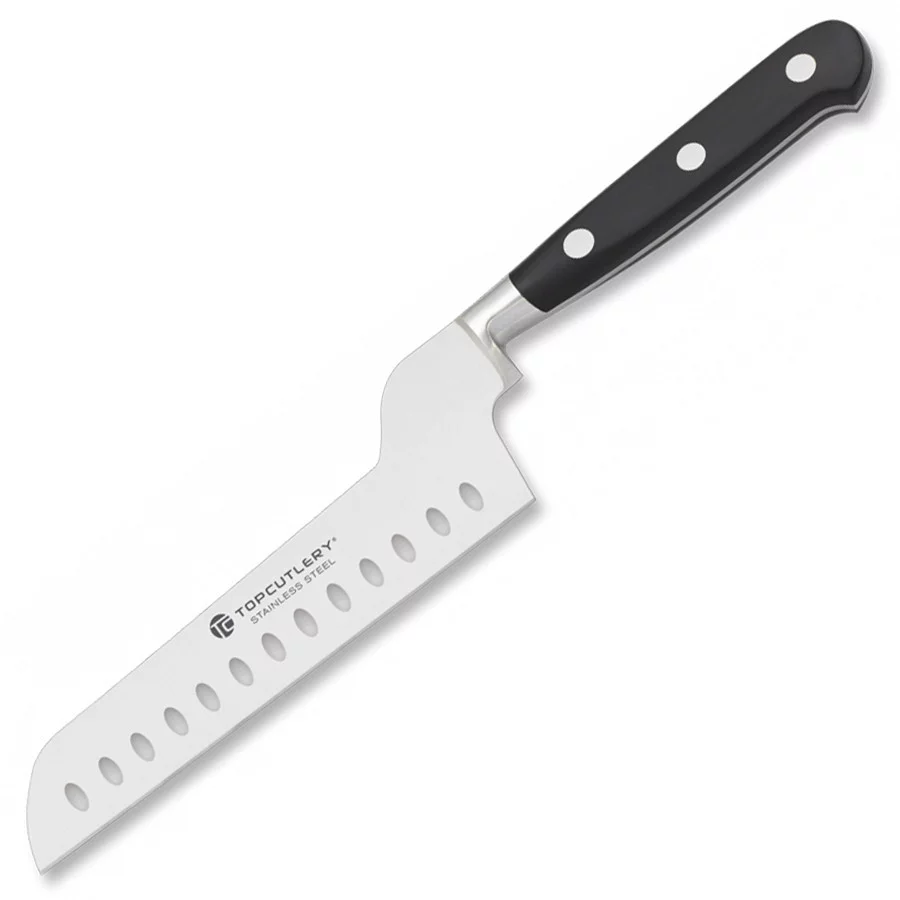
The Value of Hollows
The indentations on a knife blade represent a significant innovation in kitchen utensil design. By understanding their functionality and benefits, both professional and amateur chefs can maximize efficiency in food preparation and enjoy a smoother, more pleasant culinary experience.
| Type of Knife | Main Use | Benefit of Hollows |
| Ham Knife | Cutting ham | Facilitates fine and thin cuts without adhesion. |
| Santoku Knife | General kitchen cutting | Reduces friction when cutting vegetables and meat. |
| Butcher Knife | Meat cutting | Improves precision on thick cuts. |
The Roman pugio is an emblematic dagger of the Roman army, whose use is framed in the rich military history of Rome. This instrument was not only effective in combat but also held symbolic and aesthetic significance for the legionaries who carried it. Below, we will delve deeper into the origin, characteristics, and function of the Roman pugio.
Origin of the Roman Pugio
The pugio has its origins in the ancient cultures that inhabited the Iberian Peninsula, specifically among the Celtiberians. It is believed that the Romans adopted this weapon, known as the double-discoidal dagger, during the Celtiberian Wars in the 2nd century BC. This influence allowed the dagger to be integrated into Roman armor and military equipment, enhancing its versatility on the battlefield.
Characteristics of the Roman Pugio
- Design and Size: The pugio is characterized by being a double-edged dagger that generally exceeds 20 centimeters in length. Its pistiliform shape is typical, although specimens with triangular blades have been found, especially in the area of the British Isles.
- Central Ridge: The blade of the pugio features a central ridge that provides greater strength and rigidity, facilitating use in combat.
- Decoration: Both the sheath and the handle of the pugio often include elaborate designs, reflecting the status of the soldier who carried it as a symbol of prestige.
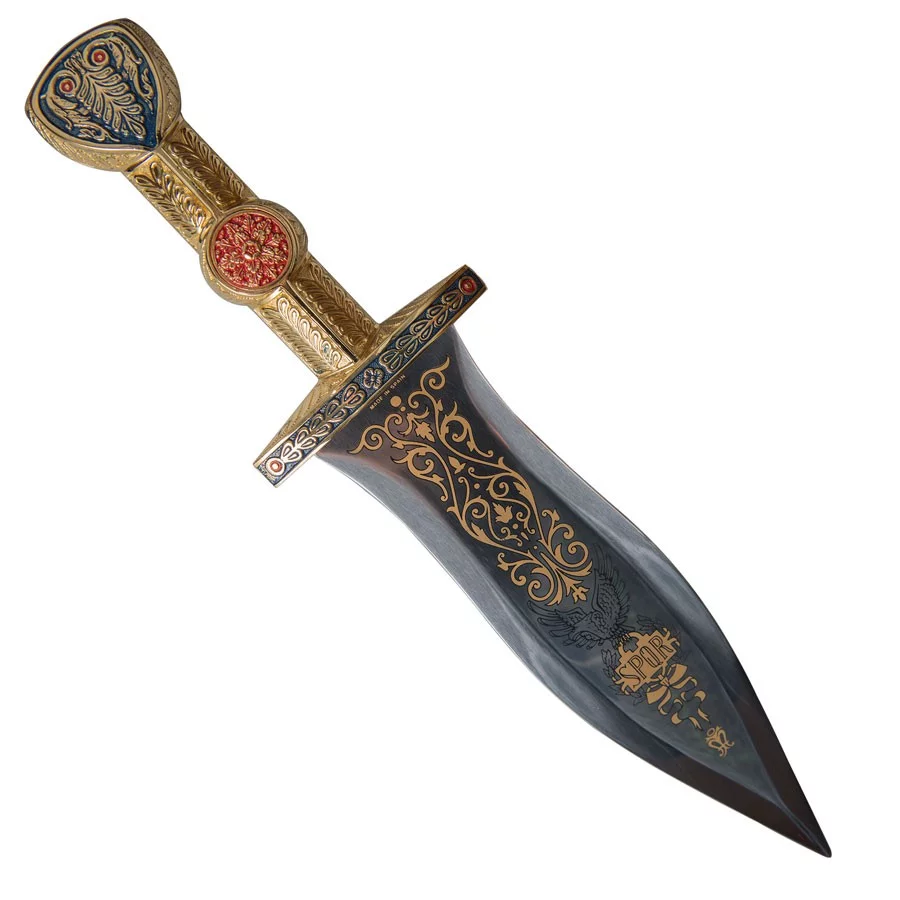
Function of the Roman Pugio
The main purpose of the Roman pugio was to act as an auxiliary weapon in combat situations. Thanks to its compact design, the pugio could be used to stab and penetrate armor, such as chainmail. It is considered that, although some historians argue that the pugio had a symbolic value, its actual use in critical moments when the gladius was not at hand is the most accepted interpretation.
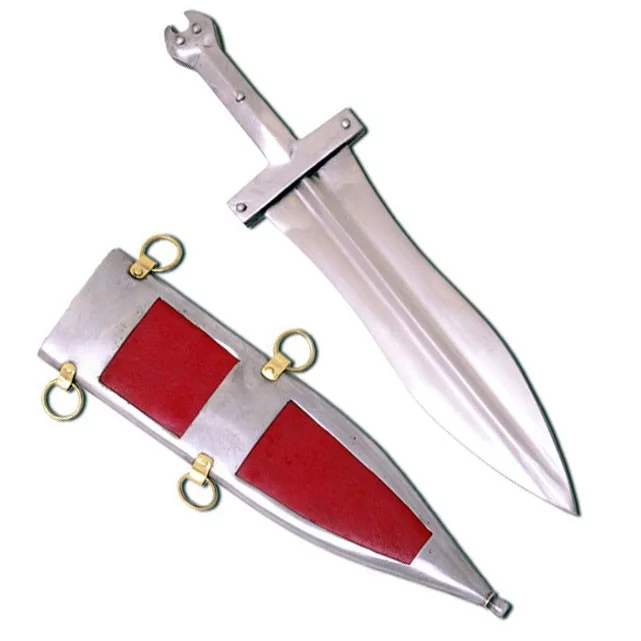
Conclusion
The Roman pugio was not only a useful tool in warfare contexts but also represented the culture and status of the legionaries. Its evolution and adaptation over the years make this weapon a fundamental part of Rome's military history.
Kitchen knives are essential tools that every chef, whether professional or amateur, greatly values. When it comes to choosing the best utensils for culinary tasks, two outstanding options are European kitchen knives and Japanese knives. Each type of knife reflects a rich culinary and artisanal tradition, making them true stars in any well-equipped kitchen. Let's explore the key differences between these two styles of knives to help you decide which one best suits your needs and personal preferences.
Blade and Material
The selection of the right knife begins with the blade and the material, which determine its performance, durability, and ease of maintenance.
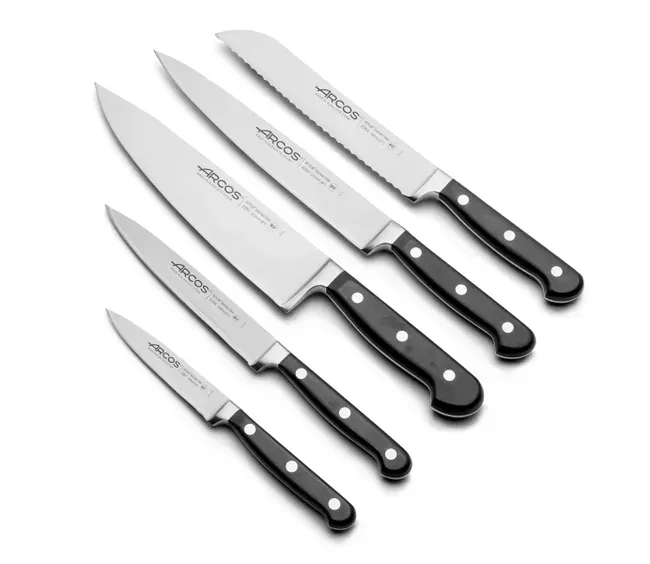
Japanese Knives
- Blade: Japanese knives are known for their thin, sharp blades, composed of a hard high-carbon steel core (HRC 60+) coated with softer layers of steel, usually stainless.
- Hardness: The hardness of the steel in these knives ranges between 58 and 66 Rockwell degrees, offering exceptional sharpness, although at the expense of flexibility.
- Benefits: Their precise cutting enhances food presentation and preserves natural flavor and texture.
European Knives
- Blade: These knives feature thicker blades with a more robust edge, ideal for cutting through bones without the risk of damaging the blade.
- Hardness: With a hardness close to 54 Rockwell degrees, they are more resistant to bending, making them perfect for tasks that require strength.
- Benefits: Durability and versatility make them an ideal choice for heavy-duty tasks in the kitchen.
Geometry and Composition
The geometry of the blade and the design of the handle are essential foundations that influence the manageability and comfort of the knife.
Japanese Knives
- Bevel: They offer single or double bevels, with the former being ideal for preparing vegetables or filleting fish.
- Handles: Traditional (wa) handles are usually made of special lightweight wood and are comfortable.
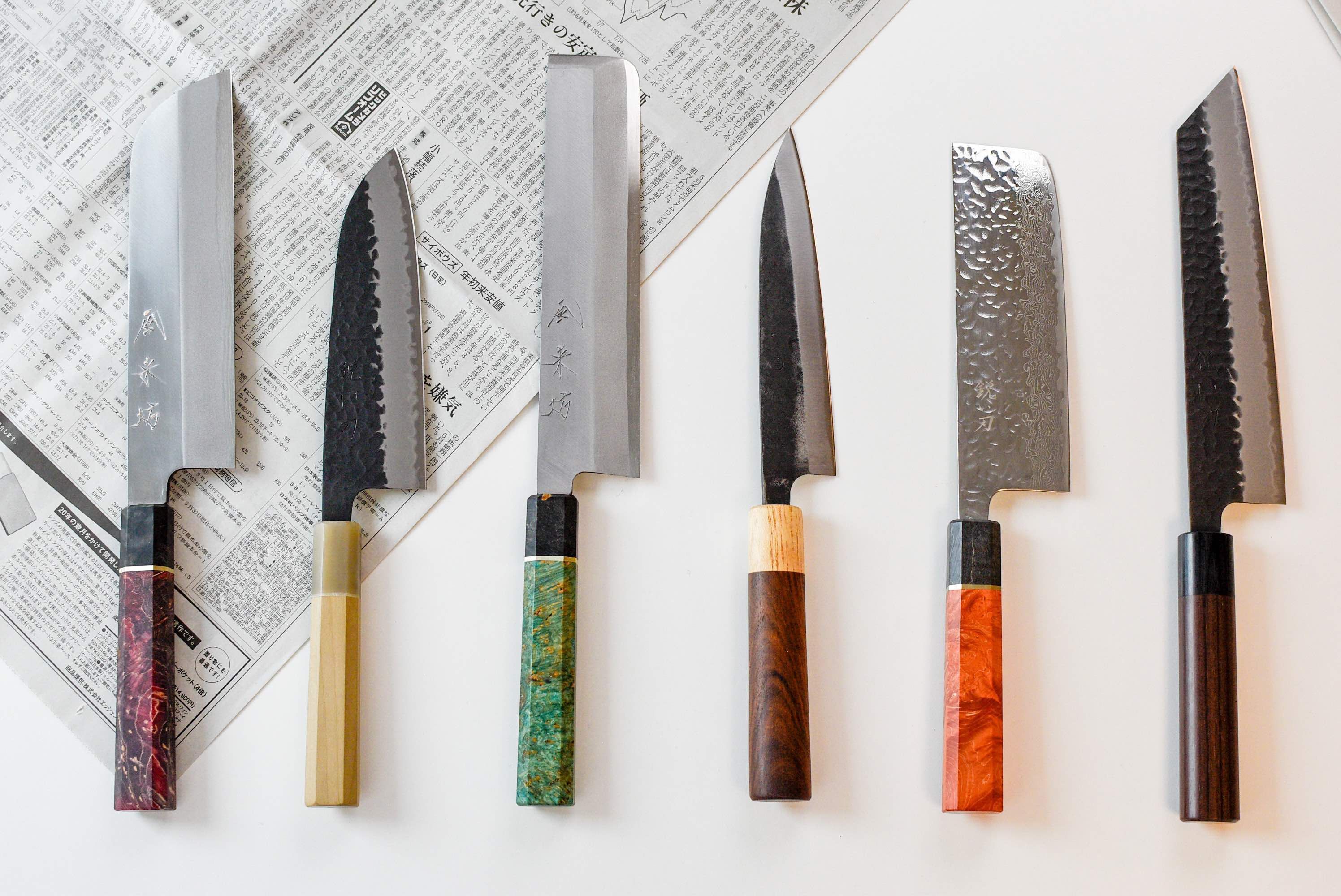
European Knives
- Bevel: While they can also be single or double, their design is generally more robust.
- Handles: Built to last, these handles are heavier and provide stability.
Usage and Care
The usage and care of each type of knife directly influence its longevity and daily performance.
Japanese Knives
- Usage: Suitable for fine tasks, they should not be used on bones or very hard foods.
- Care: They require careful maintenance but can last a lifetime if treated properly.
European Knives
- Usage: Versatile for tasks that demand strength, such as boning.
- Care: More resistant to wear, they withstand intensive use.
Philosophy and Aesthetics
The philosophy and aesthetics behind the design of each knife reflect the cultural and artistic traditions of their countries of origin.
Japanese Knives
- Philosophy: They evoke perfection (kodawari) through damask patterns and delicate lines (tsuchime).
European Knives
- Philosophy: Inspired by durability, their robust designs are perfect for more demanding tasks.
| Aspect | Japanese Knives | European Knives |
|---|---|---|
| Blade | Thin and sharp | Thick and robust |
| Hardness (Rockwell) | 58-66 | 54 |
| Handle | Cylindrical and lightweight | Heavy and stable |
| Usage | Precise cutting | Intensive tasks |
| Care | Requires attention | Durable |
Knives are an essential tool in any kitchen, whether professional or domestic. When we decide to invest in a knife set, we encounter a key decision: should we choose steel or ceramic knives? Each type has its own peculiarities and benefits, so it is fundamental to understand the differences to make an informed choice.
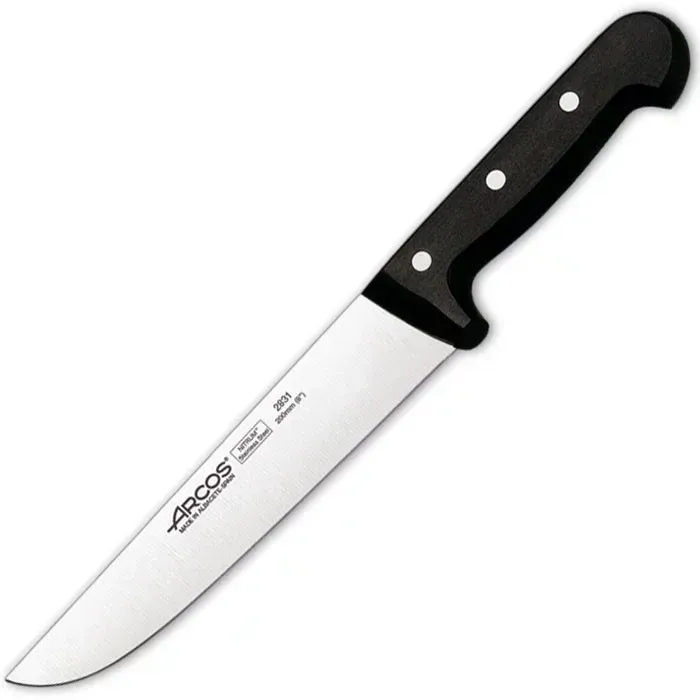
Advantages and Disadvantages of Steel Knives
Steel knives have been a basic component in kitchens for centuries. Below, we explore their main advantages and disadvantages:
Advantages
- Strength and Durability: They are highly resistant to impacts and falls, making them perfect for cutting hard ingredients.
- Sharpening and Maintenance: Steel is relatively easy to sharpen, and you can do it with common tools. In addition, they come in a variety of prices and qualities for different needs.
- Versatile Uses: Steel knives are ideal for various tasks from chopping vegetables to deboning.
Disadvantages
- Require Regular Sharpening: They need to be sharpened regularly, which might be inconvenient.
- Oxidation: Although they are stainless steel, they are not completely immune to rust and corrosion.
Advantages and Disadvantages of Ceramic Knives
Ceramic knives are a modern alternative. They are noted for their precision and hygienic appearance.
Advantages
- Hygiene and Lightweight: They are non-porous, so they do not absorb odors or flavors. Additionally, their lightweight design makes them easy to handle.
- Long-lasting Sharpness: Ceramic edges remain sharp for longer without the need for constant checking.
- Easy to Clean: Dirt does not stick to them, making washing them simple.
Disadvantages
- Fragile: Despite their hardness, they are susceptible to breakage from sudden impacts.
- Difficult to Sharpen: They require specific tools for sharpening, which can be a hindrance for some users.
- Higher Price: Although their durability may justify the cost, they are initially more expensive than steel knives.

Final Considerations
Each type of knife has a unique set of characteristics that could make it ideal depending on the context of use. Here are some practical recommendations:
- Traditional Cooking: If you prefer a proven tool, steel knives are the best choice.
- Modern Cooking: For those who value hygiene and manageability, ceramic knives are highly recommended.
- Versatile Cooking: Acquiring a set of steel knives complemented with some ceramic ones can offer you the best of both worlds.
| Features | Steel | Ceramic |
|---|---|---|
| Impact Resistance | High | Low |
| Edge Maintenance | Moderate | High |
| Sharpening | Simple | Specialized |
| Oxidation | Possible | None |
| Weight | Heavy | Light |
The Seax is an emblematic weapon of the early medieval Germanic cultures, especially used by the Saxons. This versatile knife or single-edged dagger served not only combat functions but also became integrated into the daily life of these peoples. The term "seax" comes from Old English and designates a specific type of cold weapon that played a crucial role from the migration period well into the Middle Ages.
Characteristics of the Seax
- Design: The Seax is characterized by its single-edged blade, which can vary considerably in length and width. Many Seax blades feature decorations such as braided bands or serpent engravings. The edge and back of the blade typically curve toward the tip, giving the weapon a distinctive profile.
- Grip: Organic materials like wood or horn were commonly used to make the grip of the Seax. Additionally, it was common to reinforce it with metal pommels or fittings to enhance grip and durability.
- Carrying: Traditionally, the Seax was carried horizontally in a sheath hung from the belt, positioned so that the blade faced upwards.
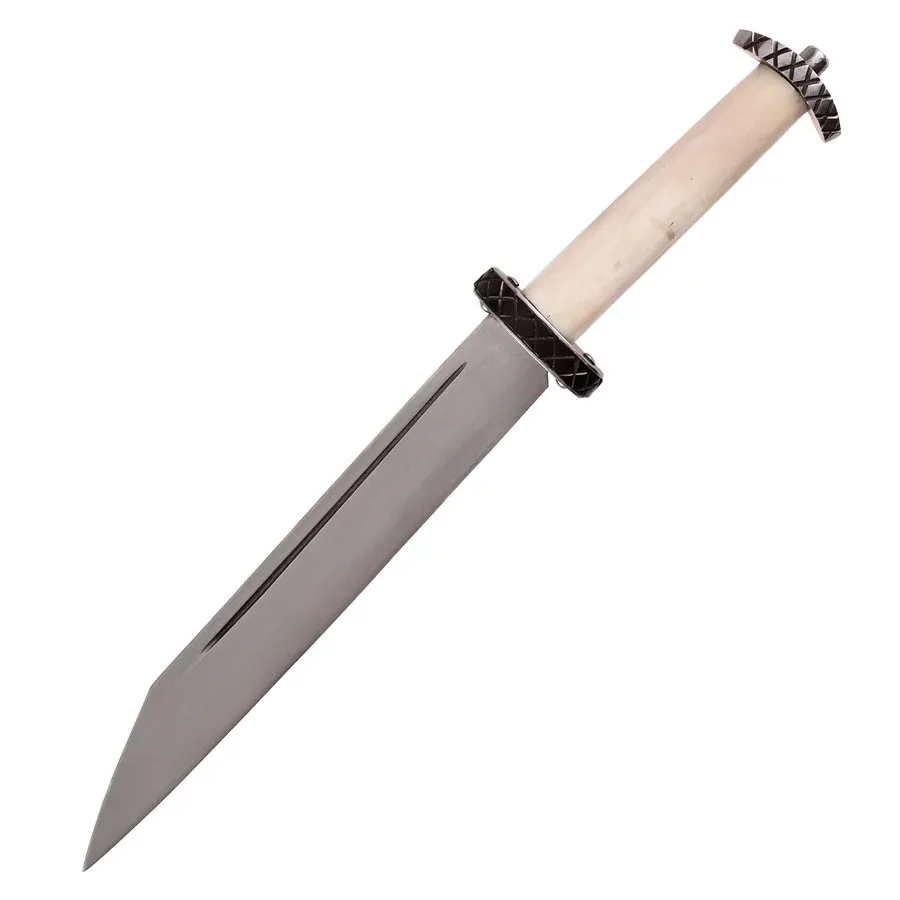
Types of Seaxes
The Seax was not a uniform weapon but presented various variants, each with unique characteristics:- Narrow Long Seax: This type features a long, narrow blade with elaborate decorations including grooves or patterned welds.
- Short Seax: A smaller version, frequently used as a secondary weapon, often showing simpler decorations on the blade.
- Broken-Back Seax: Notable for its distinctive angular transition between the tip of the blade and its back. This design has been predominantly identified in the United Kingdom, Ireland, and some regions of Germany.
- Scramasax: The most compact Seax, used by Germanic tribes such as the Franks and Goths. It was designed for stabbing and was also effective for cutting, ranging in length from 10 to 50 centimeters.
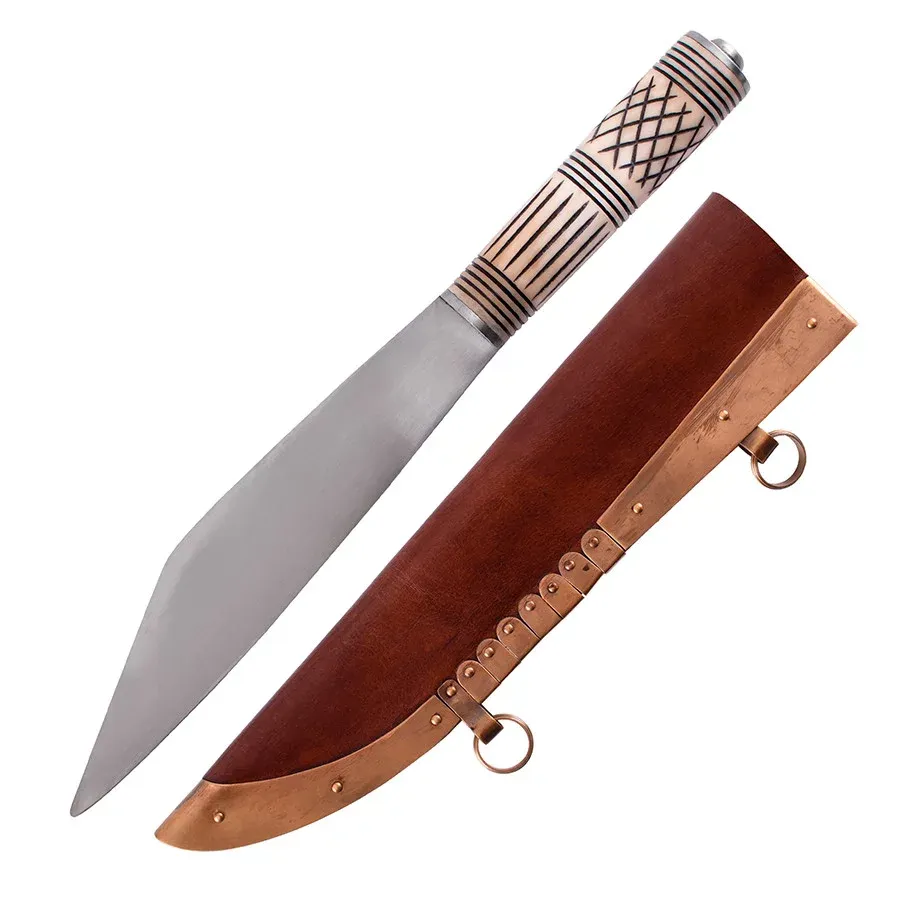
Use and Evolution of the Seax
From the 7th century, the Seax established itself as a primary weapon among the Germanic peoples, whose use spread throughout Europe. However, the prevalence of various types of Seaxes varied significantly by region. In England, although the Long Seax arrived after its acceptance on the continent, it remains exceptional in archaeological discoveries.| Type of Seax | Characteristics | Common Region |
|---|---|---|
| Narrow Long Seax | Long, narrow, decorative blade | Germanic Europe |
| Short Seax | Short blade, simple decorations | Western Europe |
| Broken-Back Seax | Angular transition in the blade | United Kingdom, Ireland, Germany |
| Scramasax | Blade between 10 and 50 cm, multi-purpose | France, Germany |
The Seax, both as a weapon and tool, is fundamental to understanding the daily life and martial traditions of the Germanic peoples. Its adaptability and evolution reflect the cultural diversity and changes that occurred in the early Middle Ages.
Throwing knives are fascinating and highly specialized tools designed to be thrown accurately at a target. Their main objective is to ensure that the tip of the knife embeds firmly into the target it is thrown at. These knives are popular among sports enthusiasts and those practicing marksmanship, providing them with a challenging and satisfying experience.
Features of Throwing Knives
Throwing knives possess a series of specific features that distinguish them from other types of knives. These design elements are intended to optimize their ability to be thrown effectively and accurately.
- Blade Design in the Shape of a Spear: This type of blade allows for a straighter throw, reducing deviations and ensuring that the tip embeds effectively into the target. The aerodynamic design is essential for ensuring that the knife maintains a stable trajectory in the air.
- Ergonomic Handle: The handles are designed to provide a secure and comfortable grip for the thrower, minimizing the possibility of the knife slipping accidentally during the throw. This ergonomics is vital for precise control.
- Weight and Balance: One of the most important aspects in the design of a throwing knife is the balance between the handle and the blade. Proper balance allows for better stability in flight and improves throwing accuracy.
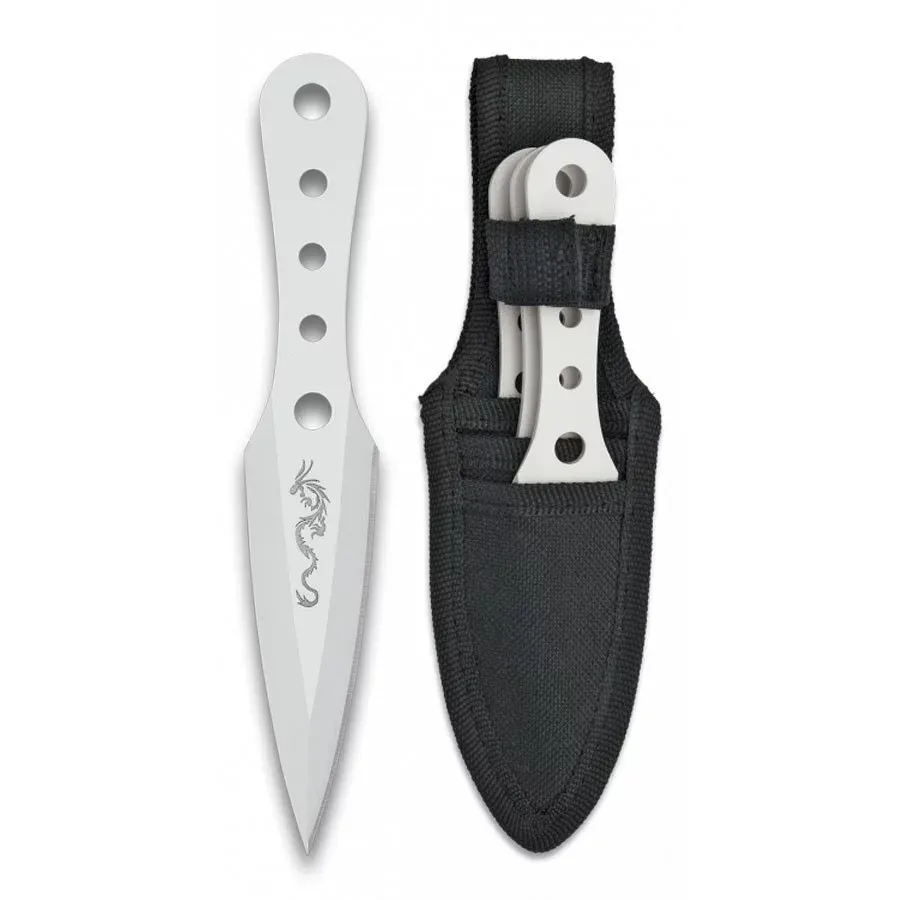
Usage and Purpose
The primary purpose of throwing knives is target practice. While it may seem obvious that these knives are not suitable for hunting or survival due to their specific design, it is an important point to consider for understanding their optimal use.
- Target Practice: They are ideal for those who wish to perfect their throwing technique on targets or tree trunks. This use helps improve hand-eye coordination and throwing technique.
- Not Suitable for Hunting or Survival: Although they can be used in some hunting contexts, their lack of sharpness for cutting and the difficulty in hitting moving targets make them less suitable for these purposes.
Types of Throwing Knives
There are various models and sets of throwing knives, each with specific features that may appeal to different skill levels of users and their personal preferences.
- Set of 3 White Dragon Throwers: This set stands out for its striking design with white dragons on the blades. Made of stainless steel, they come with a nylon sheath for protection.
- Set of 3 Black Steel Throwers with Counterweight: Equipped with a counterweight that enhances accuracy, these knives also come with a nylon sheath, making transportation and safe storage easier.
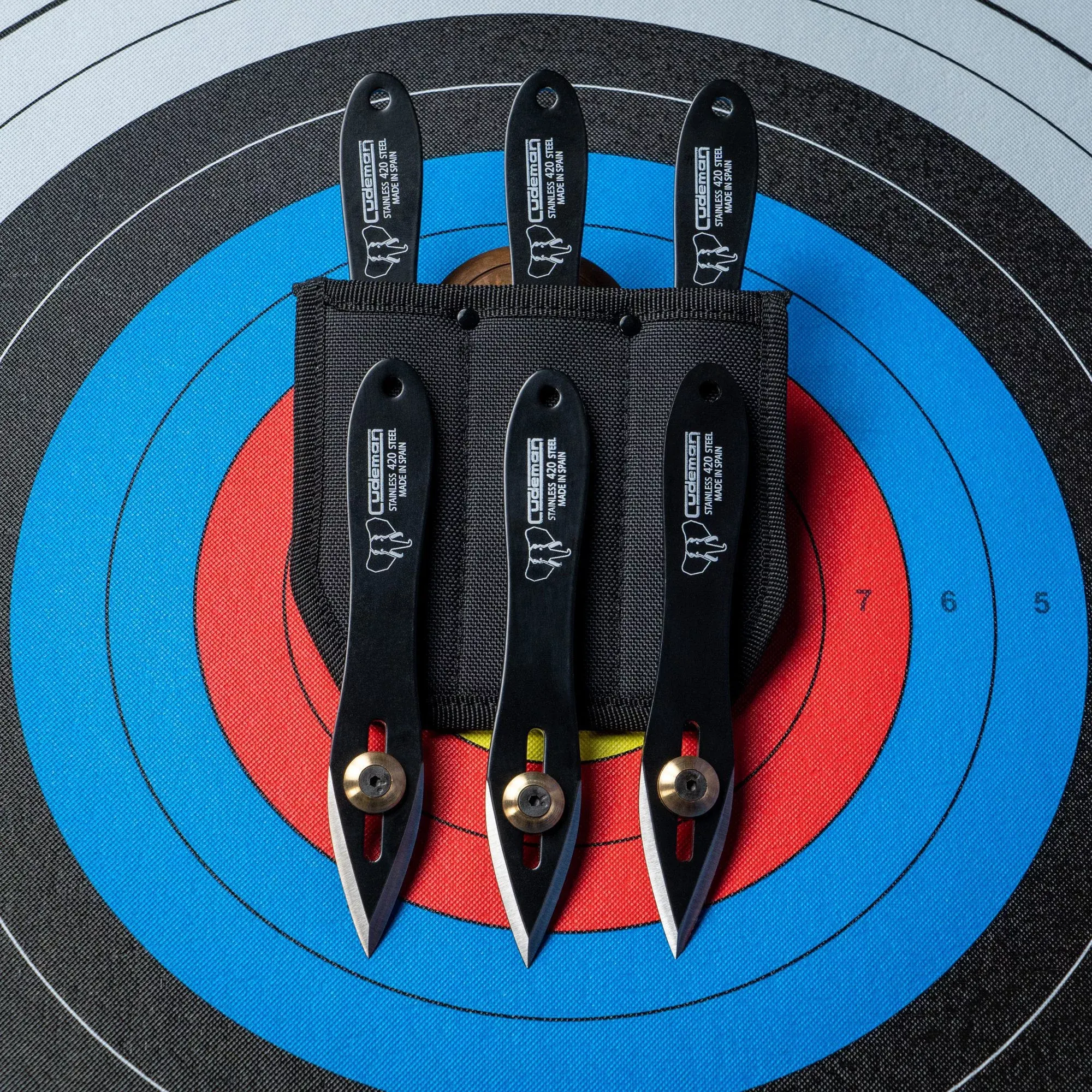
Recommendations for Beginners
For those starting in the art of knife throwing, it is recommended to begin with evenly balanced knives. These allow for easier handling and represent a great opportunity to develop throwing technique effectively. The options available in the market, such as the mentioned sets, offer variety in design and weight, adapting to the needs and preferences of each practitioner.
In general, throwing knives are an excellent tool for those who enjoy outdoor activities and wish to develop their precision and concentration skills. With their specialized designs, high-quality materials, and various model options, they represent a unique and rewarding experience in the world of sports and entertainment.
The center of gravity (CG) of a bladed weapon is a crucial concept for understanding its handling and efficient use in combat. This term refers to the point at which the weights of the weapon are balanced, directly influencing its balance, stability, and, therefore, its performance when used or thrown.
Importance of the Center of Gravity in Bladed Weapons
The balance of a bladed weapon, generated by its center of gravity, determines how it will behave when handled or thrown. A proper balance not only facilitates maneuverability but also confers precision and stability. Understanding this concept allows users, whether warriors or craftsmen, to optimize the design and use of weapons to maximize their effectiveness.
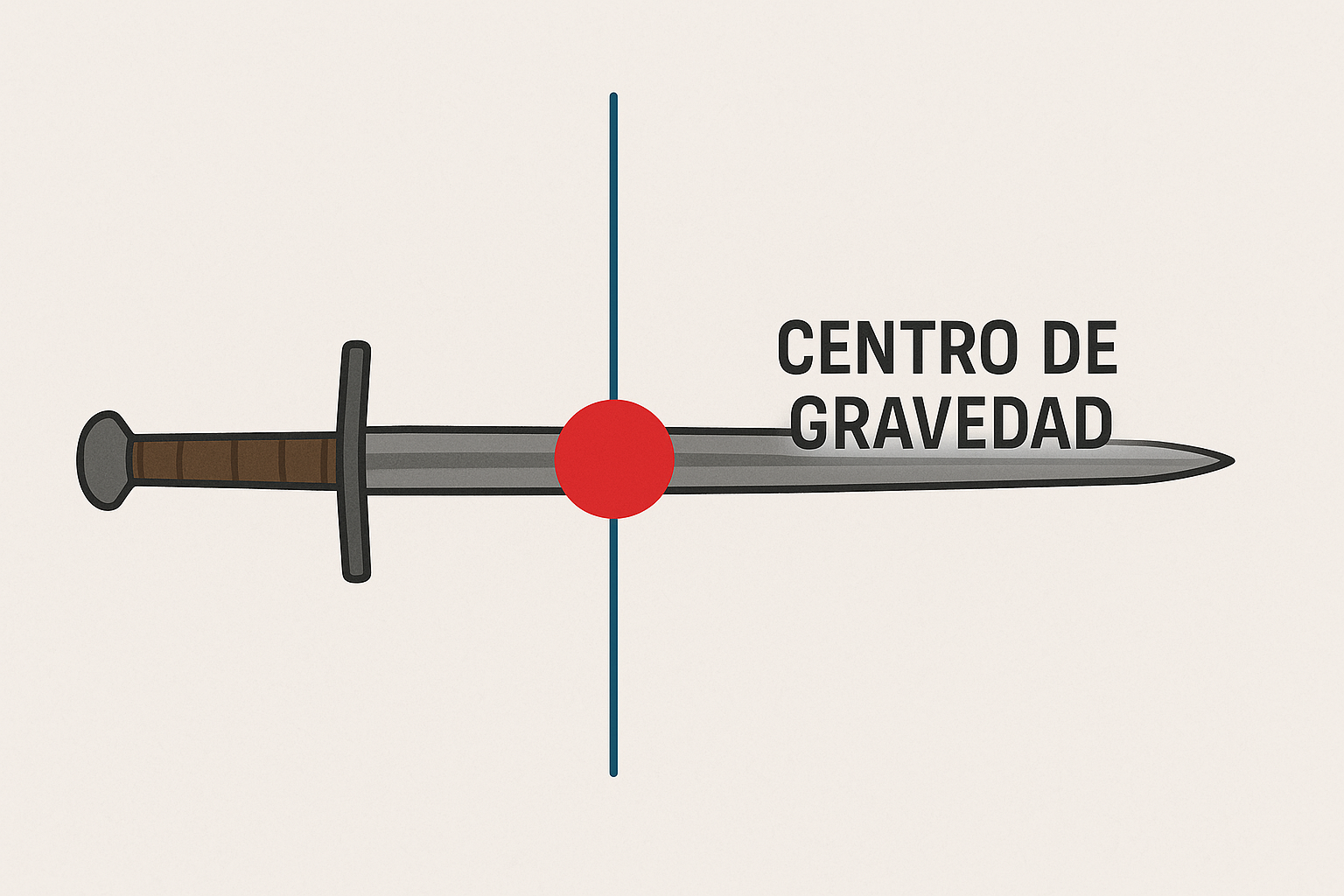
Center of Mass and Balance of Swords and Knives
The center of mass (CM) directly influences the balance of weapons such as swords and knives. The CM, located near the handle, makes the weapon easier to manipulate for striking. If the CM is close to the blade, the balance varies, making it more effective for cuts and slashes, but potentially hindering other types of strikes.
The Challenge of a Poorly Balanced Sword
Manipulating a sword with poor balance can result in ineffective use. The uncertain behavior when striking and the greater physical demand on the user can lead to quick exhaustion and inaccurate blows, endangering both the user and their attempts to execute precise strikes.
Comparison of Swords According to Center of Gravity
- Centered towards the blade: Ideal for cuts and slashes, as its balance allows for quick and precise movements.
- Centered towards the handle: Offers better control in sword strikes, allowing for greater precision and handling.
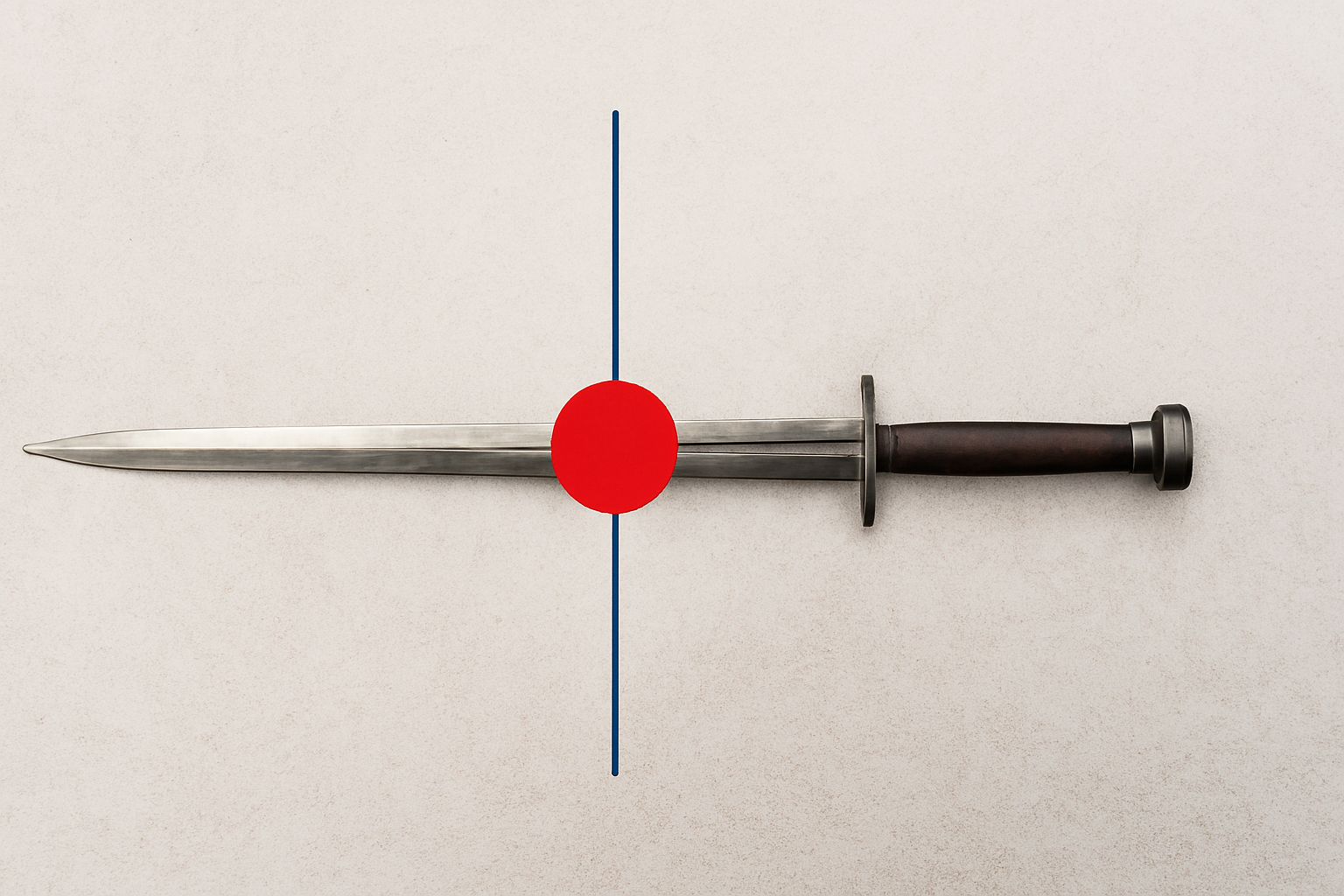
Influence of Centering on Knife Throwing
Throwing a knife requires a well-distributed CG to ensure stable and accurate flight. A CG close to the center of the knife is ideal, as it allows for a straight and controlled throw. If the CG is improperly distributed, the knife may deviate during flight, negatively affecting accuracy.
Adjustability of the Center of Gravity in Handmade Weapons
Handmade bladed weapons allow customization of the CG. By selecting materials and adjusting the weight distribution, craftsmen can design bespoke weapons that meet the specific needs of the user, optimizing the balance and control of the weapon for specific combat situations.
Bladed Weapons and the Need for a Well-Defined Center of Gravity
- Throwing knives: A centered CG improves flight accuracy, crucial for hitting the target.
- Swords and Sabres: A well-placed CG maximizes effectiveness in cuts, ensuring effective strikes.
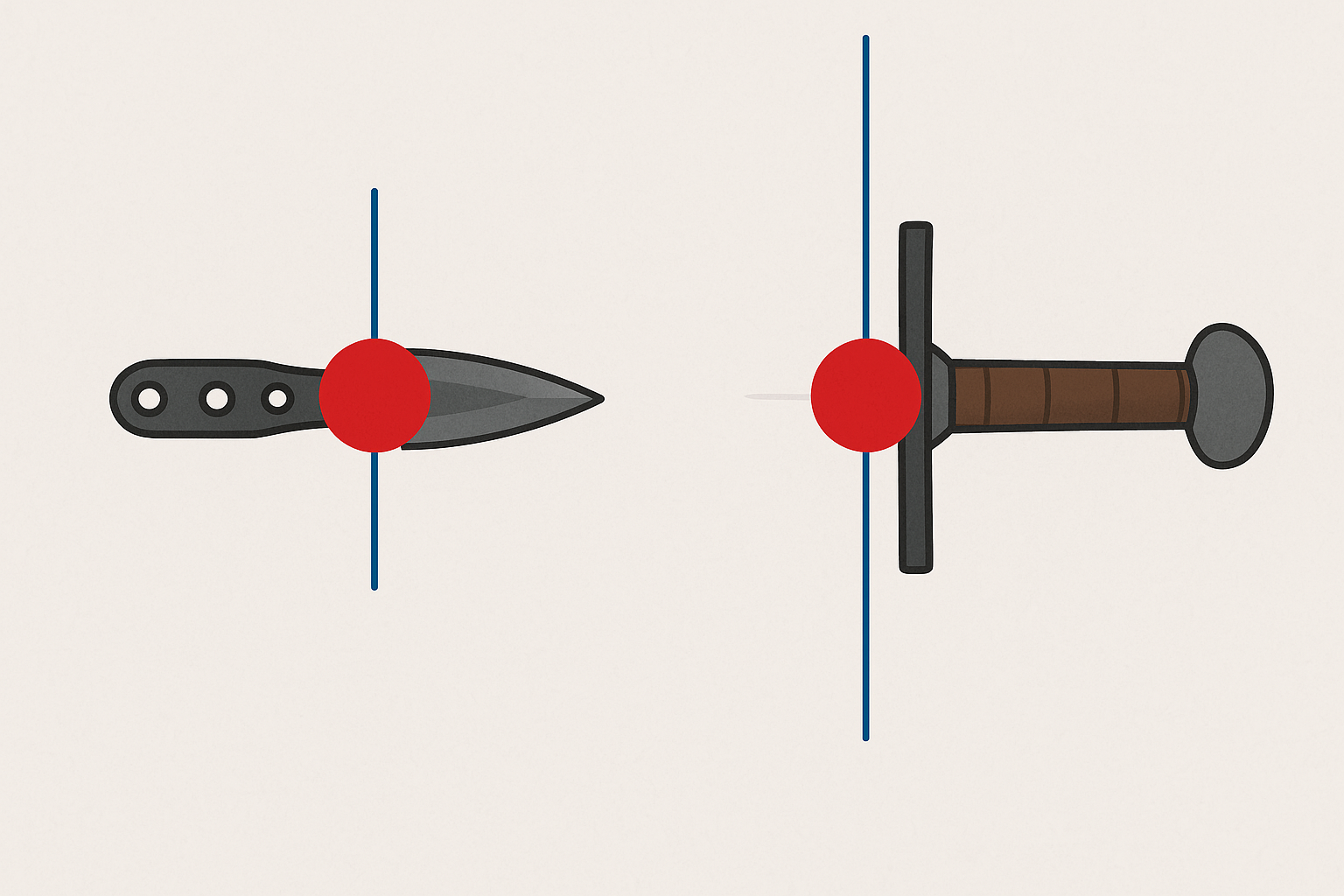
Understanding the CG in bladed weapons is essential not only for manufacturers and craftsmen but also for users, as a deep knowledge enables them to make the most of the weapon’s capabilities in combat. Customized adjustments are an added advantage of handmade weapons.
A full-tang knife is an essential piece in the world of cutting tools, widely recognized by both professional chefs and outdoor enthusiasts. The defining characteristic of a full-tang knife is its integral construction, where the blade extends along the entire handle as a single continuous piece of metal. This particular structure offers a number of advantages that make it stand out compared to other types of knives.
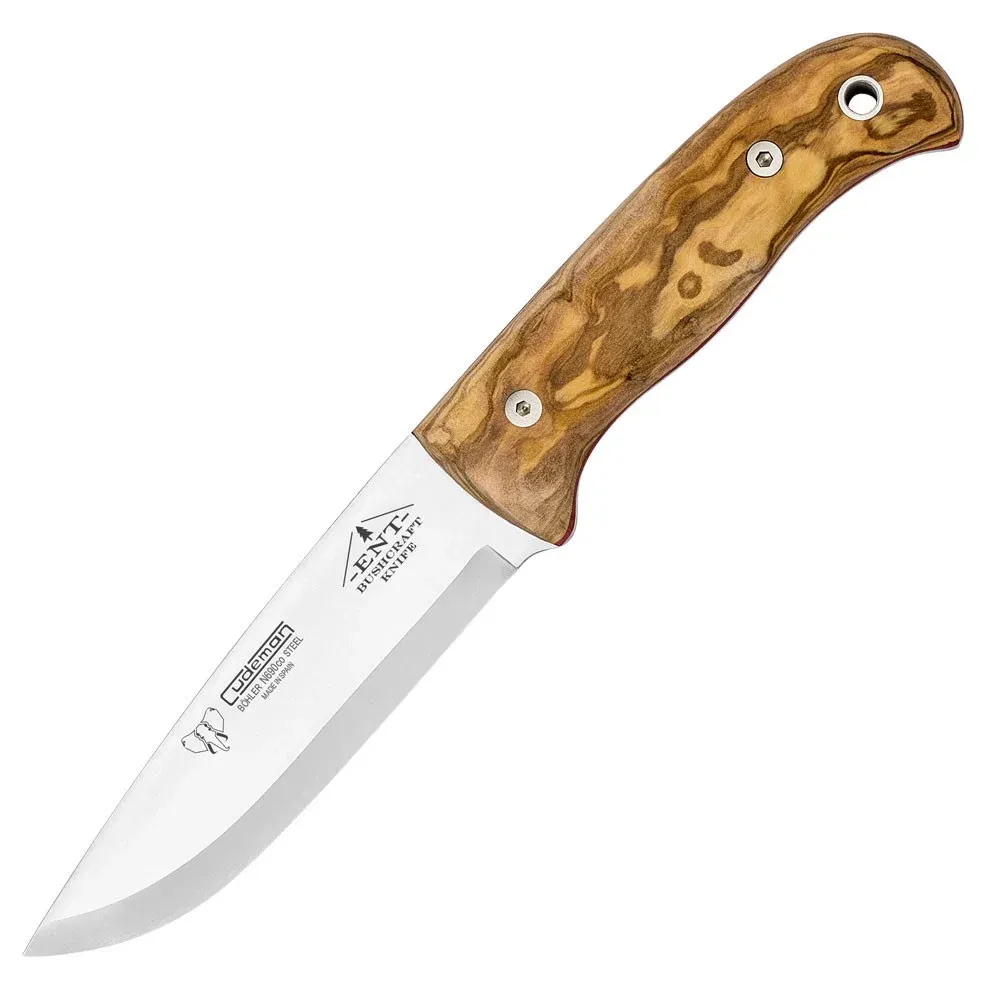
Advantages of the Full-Tang Knife
- Durability: Being forged from a single piece of metal, the full-tang knife is less likely to break or become loose over time. This makes it a reliable tool that can withstand heavy use without issues.
- Balance and Control: Its uniform design allows for weight distribution that facilitates handling, reducing fatigue during extended use. This is especially appreciated in professional culinary environments.
- Resistance to Heavy Use: Ideal for tasks that require precision and strength, such as cutting meat or carving wood, these knives perform excellently in situations that demand endurance and reliability.
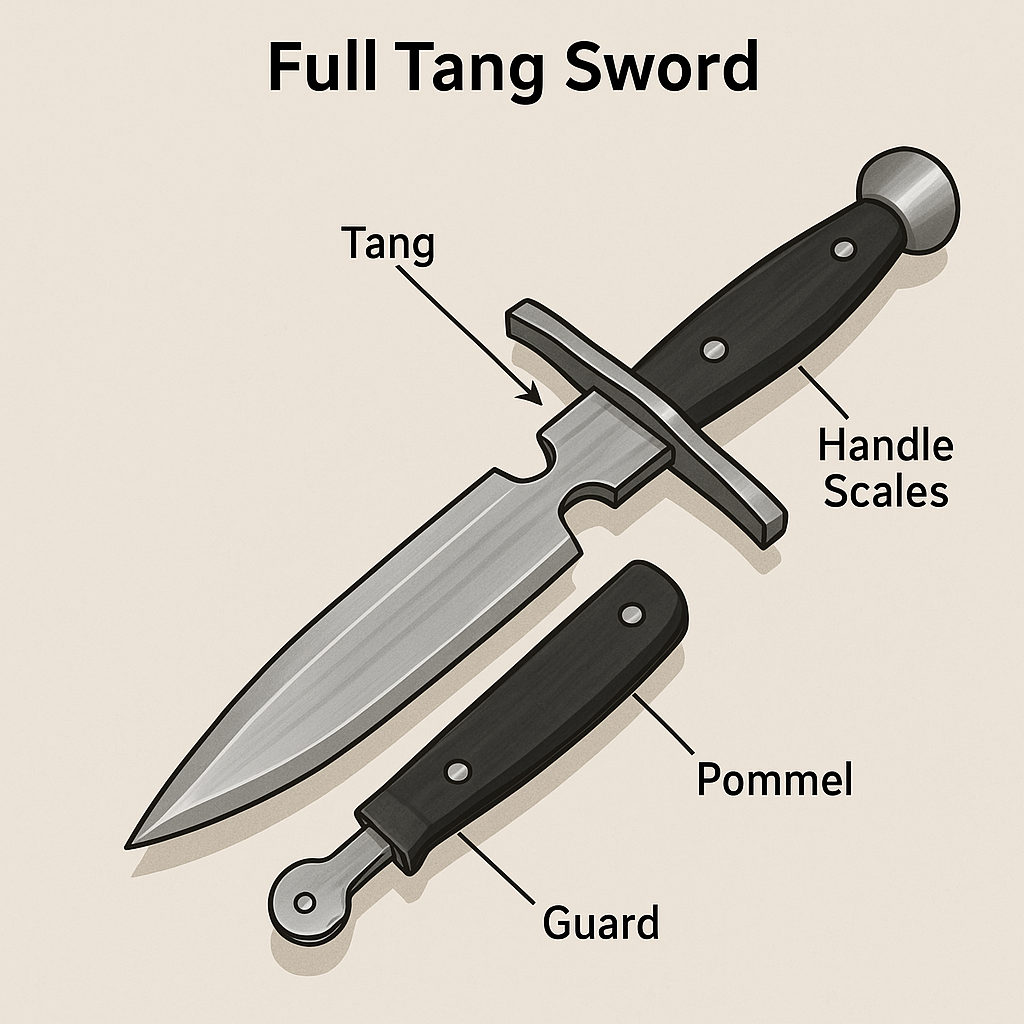
Usage and Applications
The versatility of full-tang knives makes them effective tools for various applications:
- Cooking: Famous for their cutting precision, they are essential for chefs who require reliability and durability.
- Bushcraft and Survival: Their strength and corrosion resistance make them indispensable in survival environments. They are trusted tools in extreme situations.
- Outdoor Activities: They are preferred by hunters and campers for the stability they offer, increasing confidence during use in outdoor adventures.
Identifying a Quality Full-Tang Knife
To ensure you acquire a quality full-tang knife, consider the following aspects:
- Blade Continuity: Check that the blade visibly extends along the handle, confirming its integral structure.
- Materials: High-end knives are made from stainless steel or carbon steel, both known for their durability and corrosion resistance.
- Handle: Opt for handles made of durable materials like hardwood, micarta, or G-10, which also offer excellent grip.
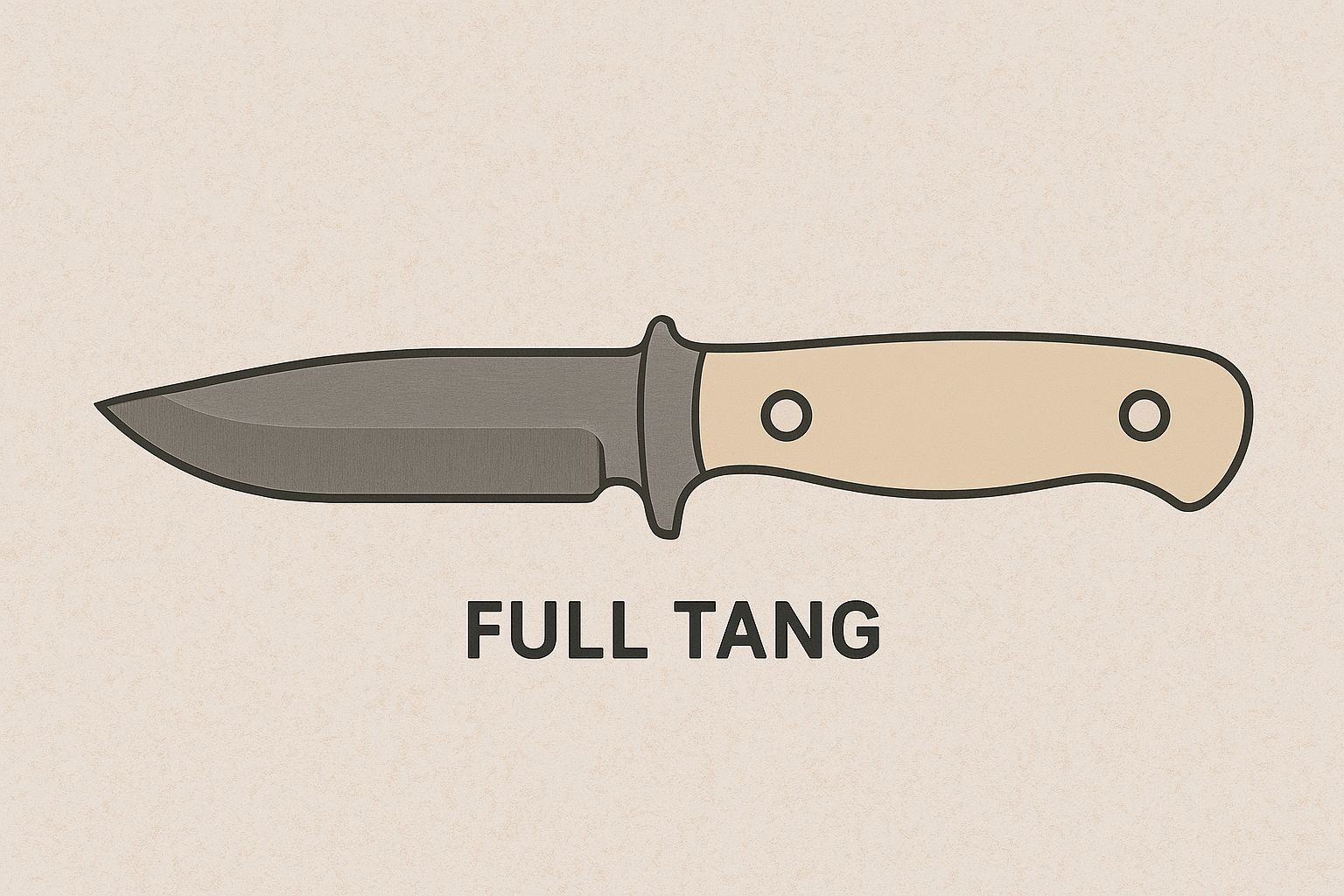
Comparison with Other Types of Knives
A full-tang knife clearly differs from other types of knives, such as those with a tang. Although both are known for their strength, the full-tang knife has the advantage of being a single piece, which minimizes the chances of structural failure.
| Feature | Full-Tang Knife | Tang Knife |
|---|---|---|
| Construction | Single piece of metal | Separate blade attached to the handle |
| Durability | Extremely high | Moderate (depends on the joint) |
| Uses | Professional cooking, survival, outdoor activities | Household use, light work |
The full-tang knife is an indispensable tool, whether in professional kitchens or in the wild. Thanks to its integral design and high-quality materials, it offers durability and efficiency, making it the preferred choice for those seeking a reliable and versatile tool.
The honing rod is an essential tool in both professional and home kitchens. Often mistaken for a sharpener, its primary function is to maintain and restore the edge of knives through aligning the cutting edge. This results in improved cutting performance and a longer lifespan for the knives.
What is a Honing Rod?
A honing rod is a hardened steel cylinder, usually equipped with a handle, used by professionals such as butchers and chefs to straighten blades. Unlike a sharpener, which removes material to create a new edge, the honing rod performs a realignment of the edge, removing burrs and aligning the microteeth of the cutting surface.
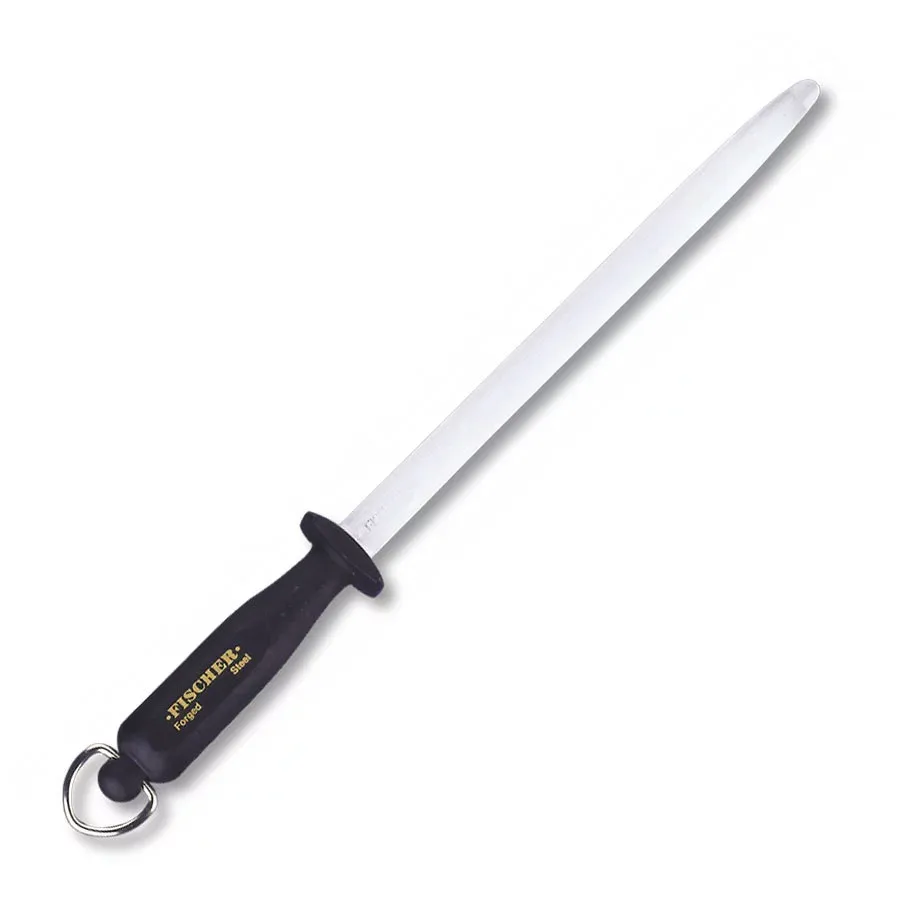
Definition according to the RAE
The Royal Spanish Academy Dictionary (RAE) defines a honing rod as a steel cylinder, generally used for sharpening or straightening blades. While there are other historical meanings, its most common use today is as a tool for honing knives.
Technical Characteristics and Materials
- Consists of a hardened steel cylinder with various surface finishes, which determine its abrasiveness—from general sharpening to fine polishing of the edge.
- Features an ergonomic handle and typically has an appropriate length for comfortably working with both large and small knives.
- The steel used is of high hardness (between 62 and 64 HRC), effective even against the hardest steels on the market.
- Includes features such as hard chrome coating and magnetization to enhance durability and retain metal particles during honing.
How to Use?
To use it correctly, slide the knife edge along the honing rod at a consistent angle, generally between 15° and 20°, alternating sides of the blade. This process aligns the microteeth of the edge and removes irregularities without excessively wearing down the metal of the knife.
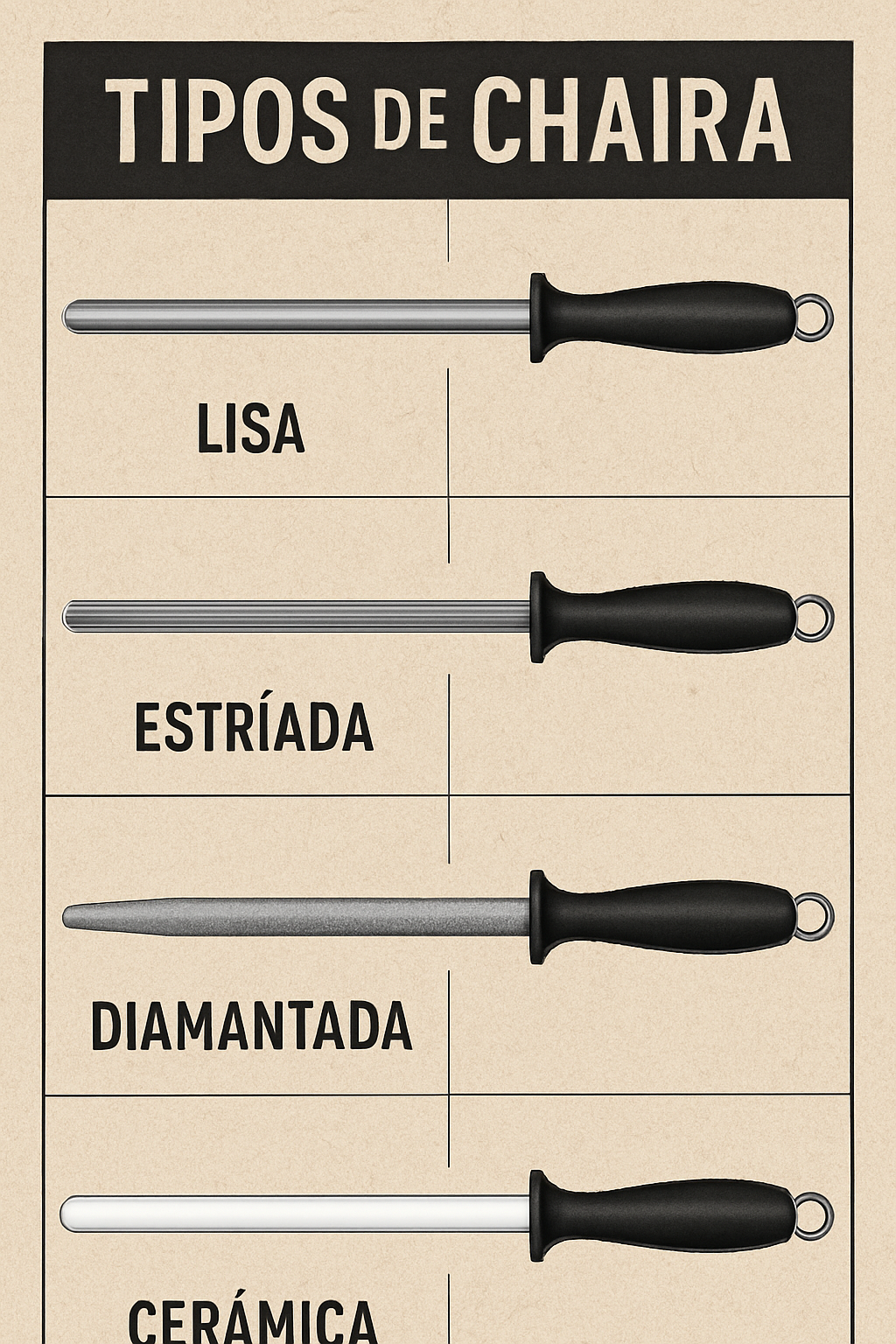
Types of Honing Rods
- Oval: Offers more contact surface, facilitating a uniform and quick honing process.
- Round: The most traditional and versatile, suitable for different types of knives.
- Flat or square: Useful for specific applications or very dull edges.
- With different surface finishes: Standard, fine, or extra-fine depending on the desired finish of the edge.
Differences from Other Sharpeners
It is essential to differentiate the honing rod from other sharpening devices such as stones or electric sharpeners. While these last remove material to renew the edge, the honing rod only realigns and maintains the edge, making it ideal for daily use and reserving aggressive sharpening for when it is truly necessary.
Importance in the Kitchen
For both professional chefs and home cooking enthusiasts, the honing rod is indispensable for achieving precise and safe cuts, ensuring optimal performance of the knives. Regular use reduces the risk of accidents and prolongs the life of cutting tools.
| Function | Description |
|---|---|
| Maintaining the edge | Realigns the cutting edge without wearing down the material. |
| Versatility | Useful in both professional and home kitchens. |
| Material | Hardened steel cylinder with high durability. |
| Differentiation | Different from sharpeners that remove material. |
















